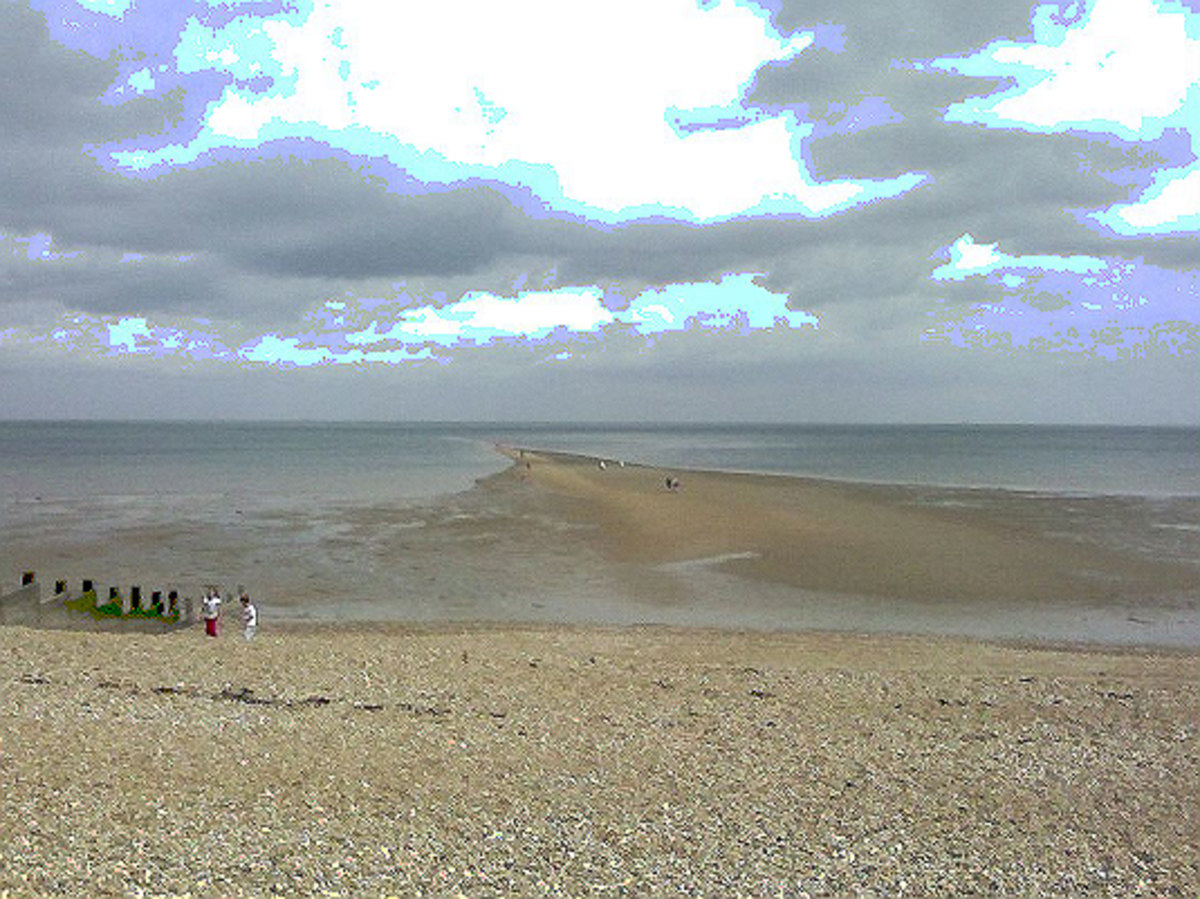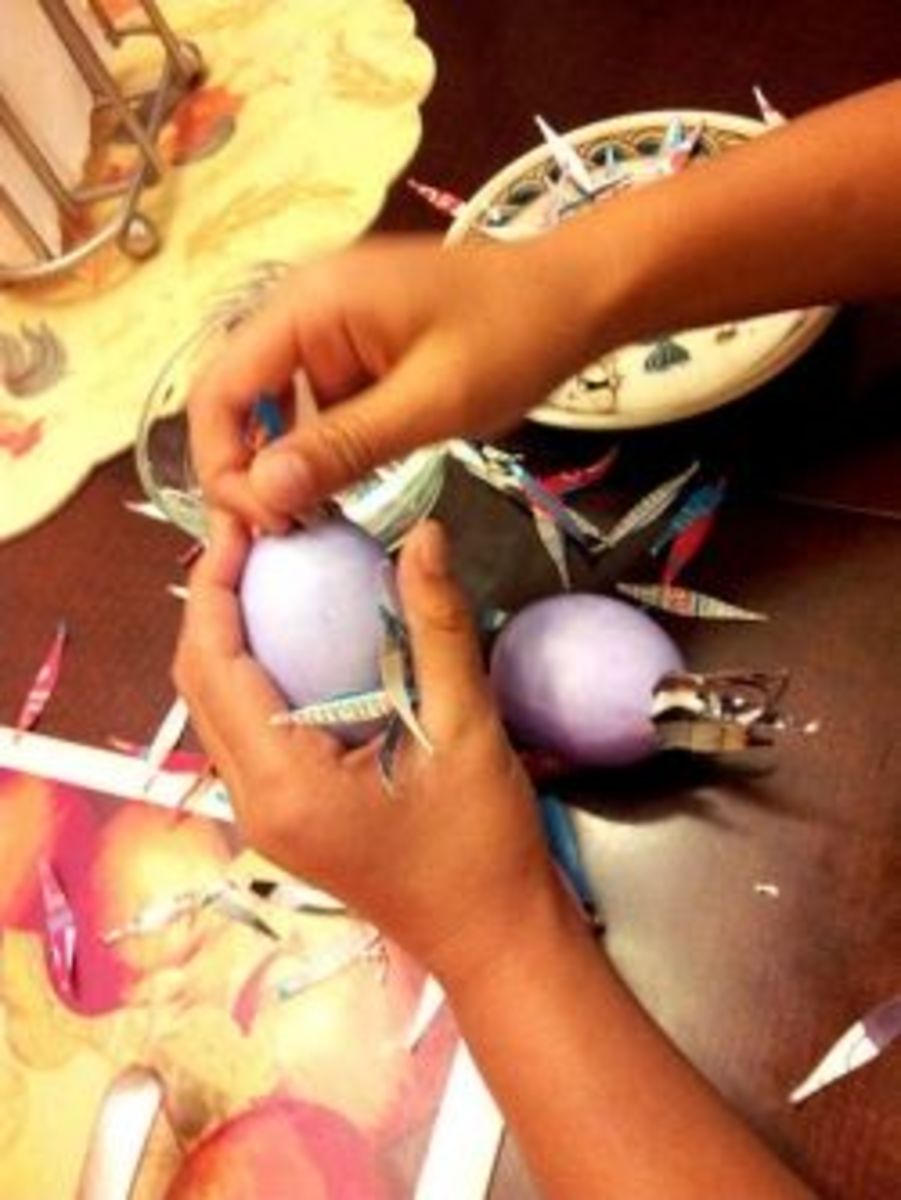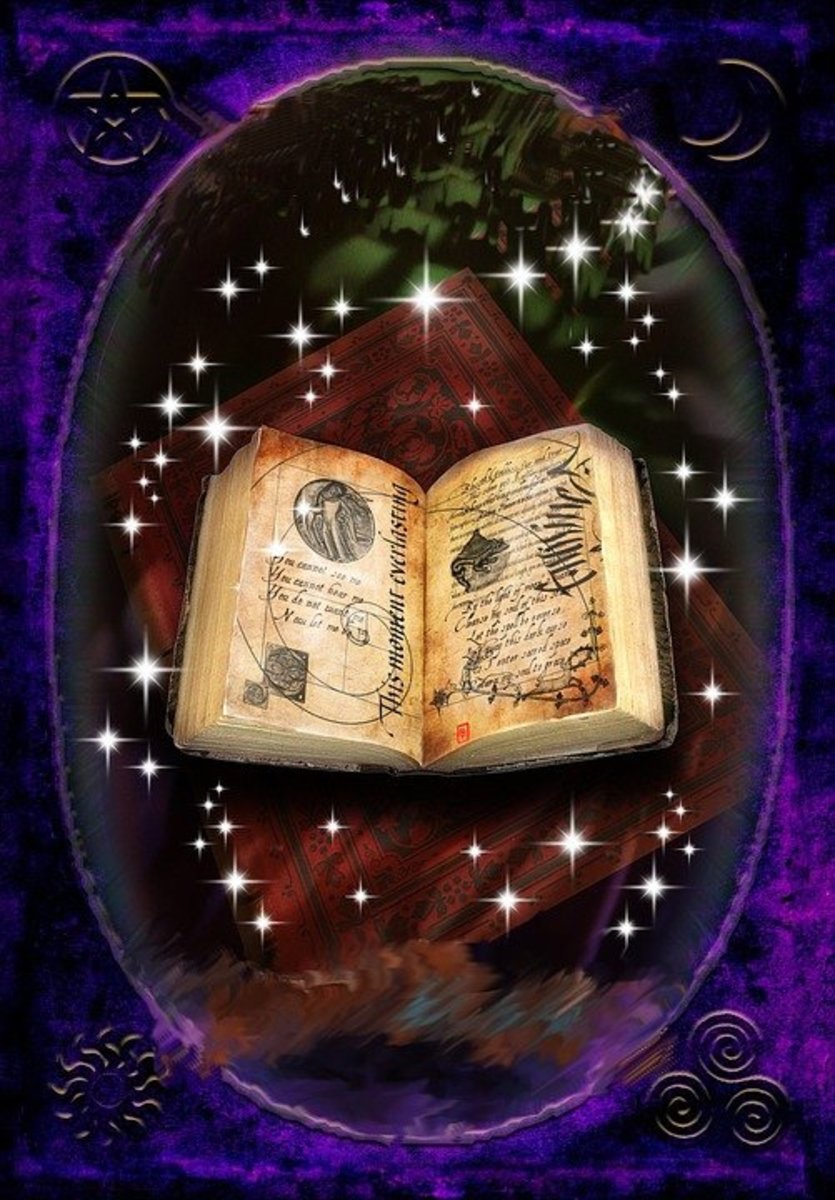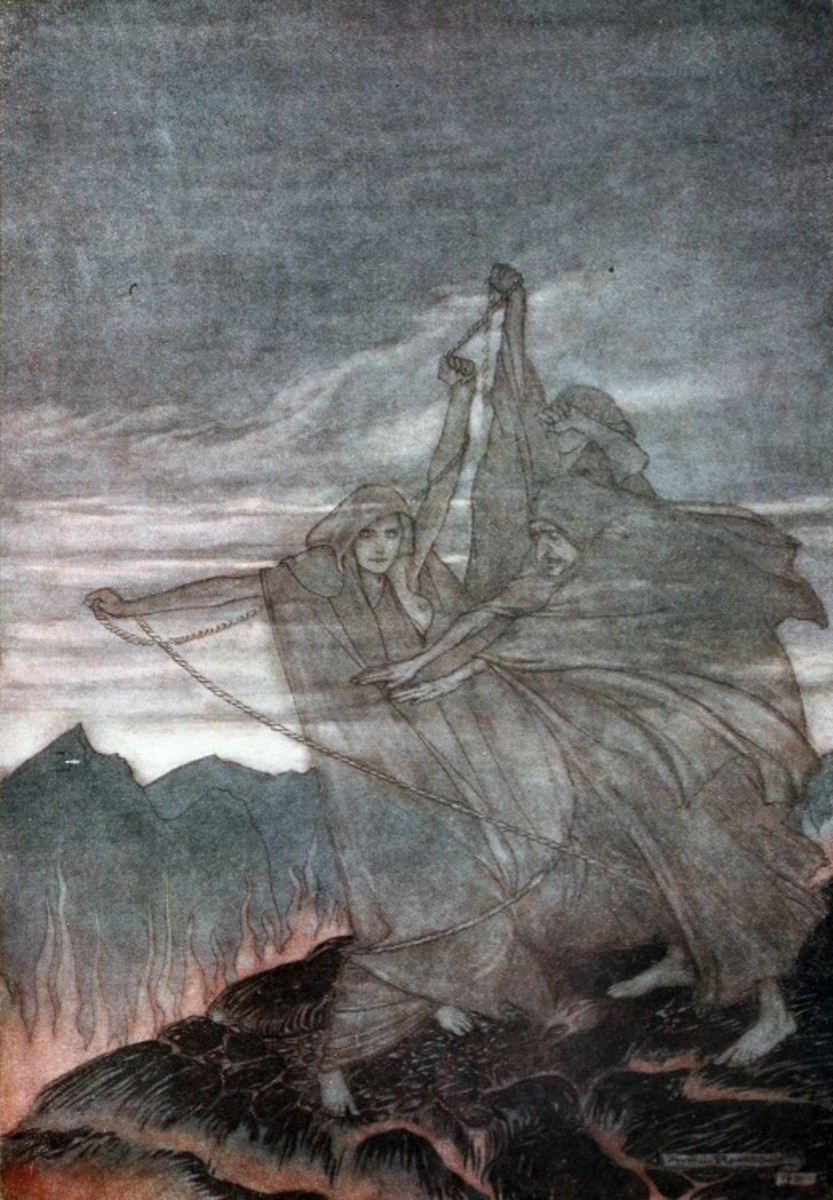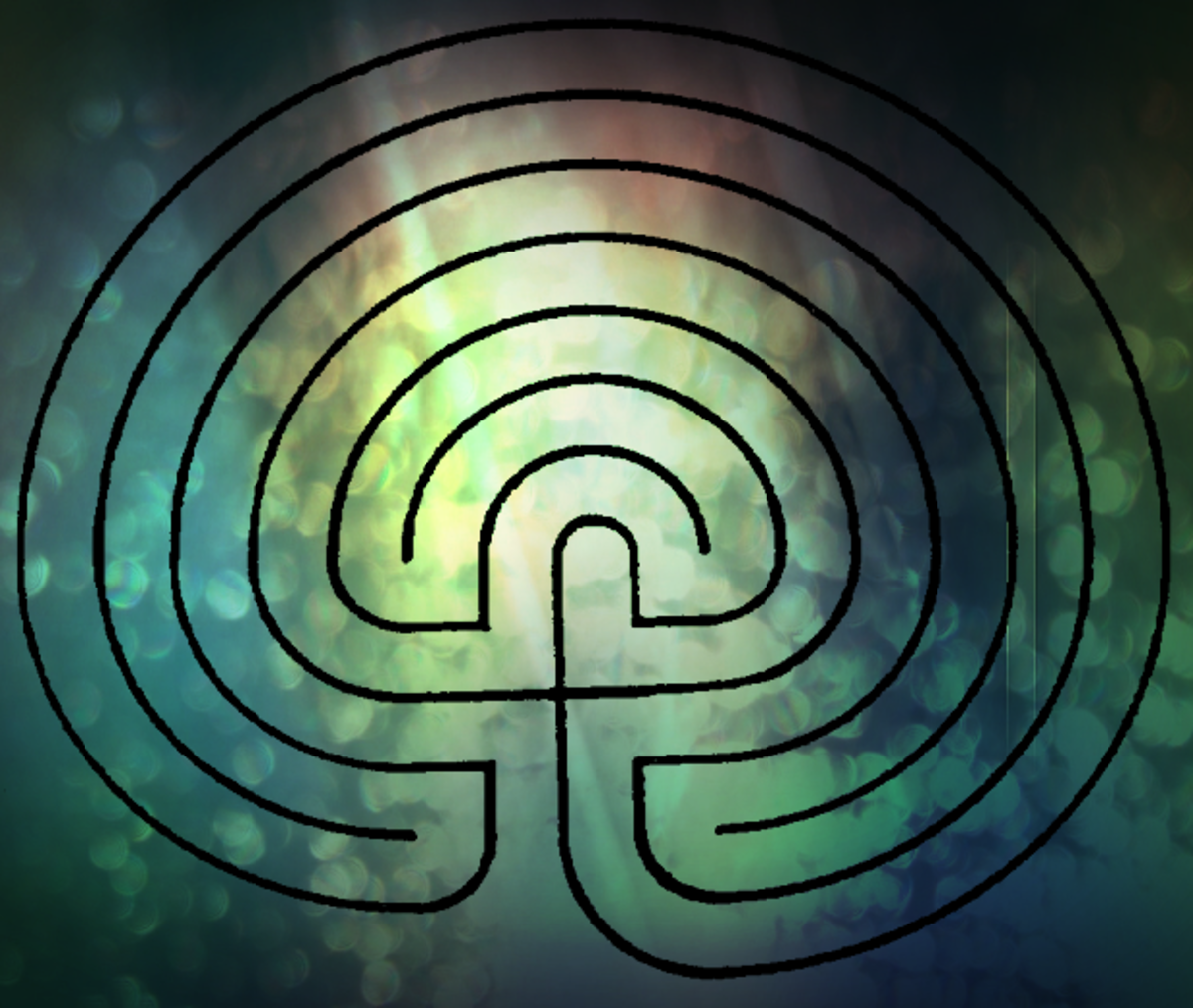The Landscape Zodiac of Britain part 9 Aries & Oester
East is Aries and Aries is the forehead and brain; the moment of sunrise; the two hours from 6am to 8am; the end of Winter is the moment when the Sun, travelling north, crosses the equator - we call that the Spring or Vernal Equinox.
The astronomical fact that actually, at the Vernal-Equinox, due to precession, the Sun really rises in the final-degrees of Pisces, about to move into Aquarius - doesn't really matter.
If we were really-clever someone would devise a whole new system of astrological philosophy... 'cos for the past couple-a-thousand years we've been basing our zodiacal-thinking on the house-systems that always place Aries on the cusp of the 1st-House at Sunrise on Vernal Equinox - and that would all have to be 'adjusted' to fit into the new-paradigm that would naturally (and of necessity) emerge if we altered astrology to reflect the actual astronomical-facts. We'd have to alter the 'cosmic-clock' so that at 6am instead of the Sun philosophically rising like the Ram, it would, at present, have to be symbolised instead as 2-fish, and that kinda doesn't work. And in a few short decades, we'd have to alter that again and start symbolising the Equinoctial-Sunrise as a human-being holding two-vases - Aquarius.
So that's why we continue to celebrate Spring-Equinox when the Sun crosses the equator in Pisces and call it Aries.... as it heads-north to the Tropic of Cancer which is actually in Taurus. As you can see from the picture, this means that Winter-Solstice nowadays happens in Scorpio, and Autumnal-Equinox in Virgo. The metaphors don't work.
Phew. That's sorted that out then.
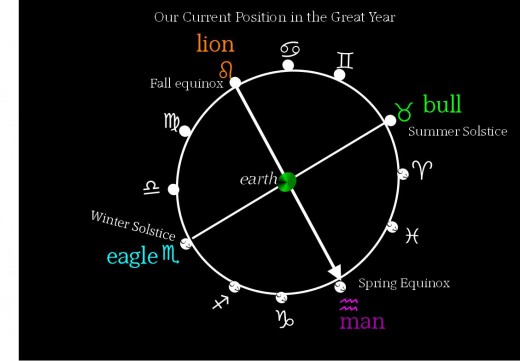
A-Rise, Aries, it's 6-0-Clock
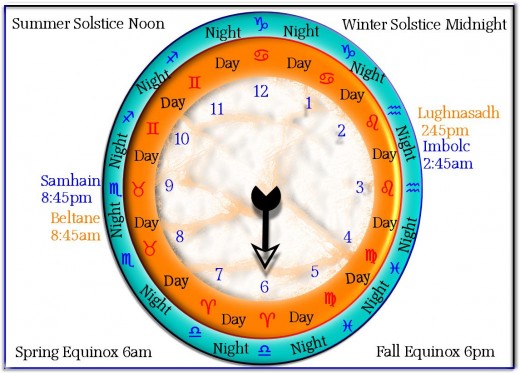
In the previous article re: Pisces I ommited the detail regarding the alignments as seen from The Hinge due to both wheels pointing in the same direction. And it's pretty much the same situation here, in Aries - the alignment from The Hinge and the alignment from Canterbury point to the same place. East.
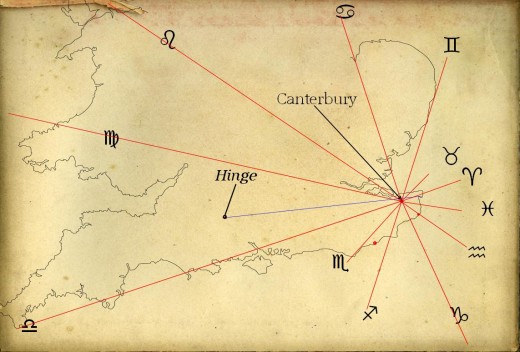
And... as Aries is the sign of The Warrior as well-as War, showing you at the out-set that the Aries 'cone-of'-influence' includes Northern-Germany, the old Soviet-Union and southern parts of China, gives a clue to the influence this sign has on the world.
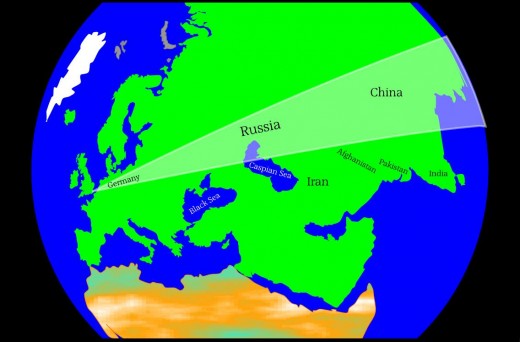
We'd better have a butchers-hook first-of-all at the traditional attributes and correspondencies that 'go-with' the sign of The Ram, though you probably know them already....
Mars

Aries: The Will
Planets: Mars & Mercury, the Sun exalted
Animals: The ram; the lamb and the war-horse
Orientation: East
Body: Head/Forehead; sight and sound
Time of day: 6-8am, Sunrise
Time of year: Spring Equinox; Easter; The Resurrection
First House: Self Will
Element: Cardinal Fire
Metal: Iron
Tarot Arcana: 1, The Magus and 4, The Emperor
OK then, the Sun leaves the Underworld of Winter and crucified, dead-things, entering Aries in the month of March, the 21st usually. Y'know, they say that March is named after Mars - because Mars rules Aries - and that's probably true. But march is also a word we use to describe soldiers on the move, marching. And well, you know, that totally corresponds to the 'cosmic-correspondencies' attributed to the sign where everything begins.
Everything starts moving again after the still, motionless time of winter. Aries governs the moment of Sun-Rise, 6am by the cosmic-clock, the time to get marching. The time for spring - time to spring-up out of bed and get on the march.
And yeah, the alignment from The Hinge runs-along our National-Angel's out-stretched legs and hits 'its' big-toe - more-often known as the (former) Isle Of Thanet. The alignment from our angel's ankle-joint in Canterbury goes to the same big-toe... so, march is a particularly appropriate name for the month of the Spring-Equinox in our land. Our giant goes marching, and Nature responds...
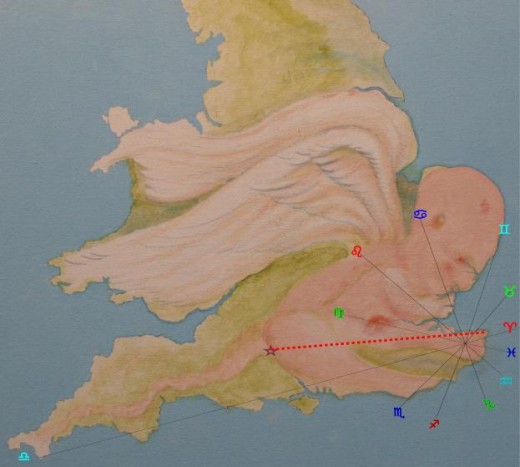
I may have mentioned this before - the landscape of Kent is divisible by the number seven when the standing-stones in St Augustine's Abbey, Canterbury are taken as the centre - it's 1x7 due-north miles from Canterbury to Whitstable (Cancer), 2x7 miles due-south from Canterbury to Folkestone (Capricorn), and 2x7 miles due-east from Canterbury to Ramsgate cliffs, and THAT's in Aries, the Ram.
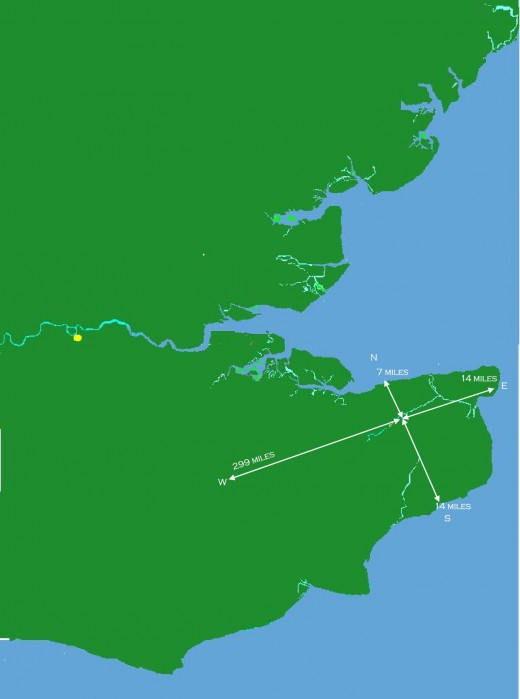
Taking the western (Libra) line, it's 299 miles from the ankle-joint Canterbury to the tip of our cherub's double-ended tail of serpentine....Lands End and Lizard-Point. Even that mileage is divisible by seven: 299 / 7 = 42.714. And that number divided by seven gives us 6.1. (and 6+1=7). So from the ankle to the tip of the tail is 6.1 x 7 x 7 miles! I think that's incredible, don't you?
Those standing-stones in St Augustine's Abbey were placed there very, very carefully, in pre-history. I wonder how they managed that?
But it's more even-more geometrically interesting than that - the nation is enclosed in a triangle - a right-angled-triangle.
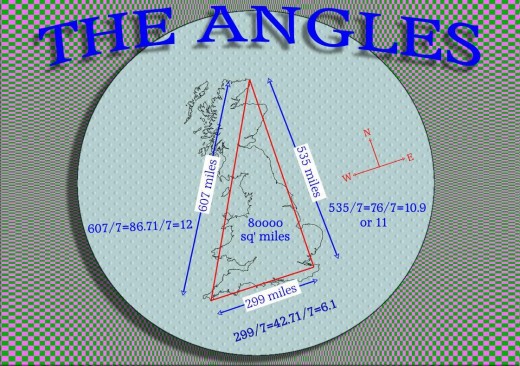
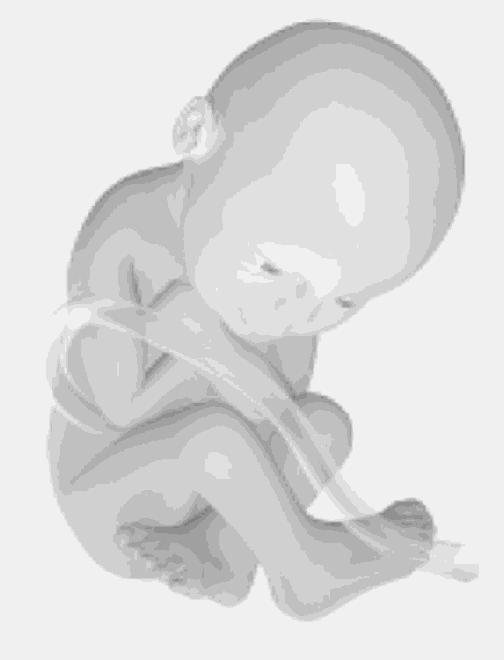
The northern line of the triangle measures 535 miles - and when we divide this by seven we get 76.4, very close indeed to 77; any-road - divide THAT by 7 and we get 11.
The 'hypotenuse' connecting the northern tip of the triangle to our big-baby's tail, is 607 miles, divide it by 7 and we get 86.7, almost 88 - we've got a double 7 and a double 8 - and 88 / 7 = 12.
So we 'end-up' with values of 6.1 along the bottom edge, 11 along the northern alignment, and 12 on the hypotenuse. And this IS a nearly perfect right-angled triangle!
What are the chances of that eh... angles and angels.
To find the area within that right-angled-triangle we multiply the base-line by the up-line, and get the area of a rectangle (159965 sq'miles), and then divide that in two to arrive at the figure 79932.5 sq' miles! THAT'S so close to the round-figure of 80,000 it's mind-boggling - merely sixty-four sq'-miles miles short of it.
Oh my goodness, I could get quite carried away with these numbers, and what they signify. If we add-together the digits of that sq' mile figure 7+9+9+8+2+5 we get that incredibly significant number appearing - 40. Really significant here because 40 is a code-word for all sorts of things related to gestation and birth - 40 weeks in the womb, and baby is born.
Triquetra
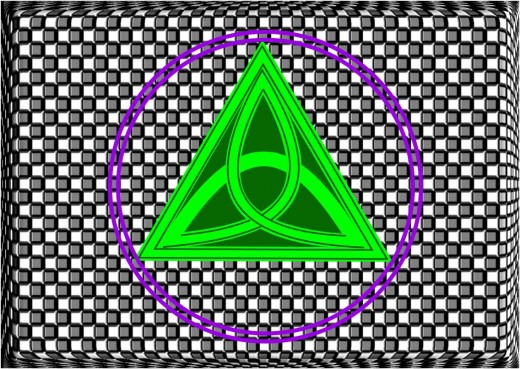
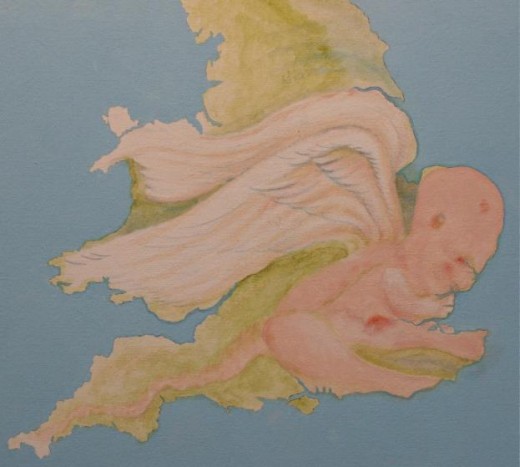
So, we live within (many of us) a triangle, a three-sided or triadic emblem. Three is as significant as number 40.
3 represents the union of the numbers that come before it (1 & 2). The 1 represents force (a wand/phallus); 2 represents an opening (a cup/chalice/yoni); and when they combine then the resulting 3 is the birth of a new element - emblematically, represented as a child.....
3 = ♦ Waxing, Waning, Full ♦ Spirit, Mind, Body ♦ Father, Son, Holy Ghost ♦ Mother, Father, Child ♦ Past, Present, Future ♦ Power, Intellect, Love ♦ Creator, Destroyer, Sustainer ♦ Creation, Preservation, Destruction ♦ Thought, Feeling, Emotion ♦ Mother, Maiden, Crone ♦ Love, Truth, Wisdom.... and here in the Isles Of The Gods ♦ Wales, Scotland and England.
Number 3 is magic, intuition, fecundity and advantage - invokes expression, versatility and joy of creativity - represents Past, Present and Future - is adventures, cooperation from others, reward and success, personal growth, human development and spiritual expansion. The three-worlds.
¶ the Otherworld: where spirits, gods and goddesses live.
¶ the Mortal World: where you and I live with the plants and animals.
¶ the Celestial World: where unseen energies exist and move - like forces of sun, moon, wind and water.
where'd they get the idea?
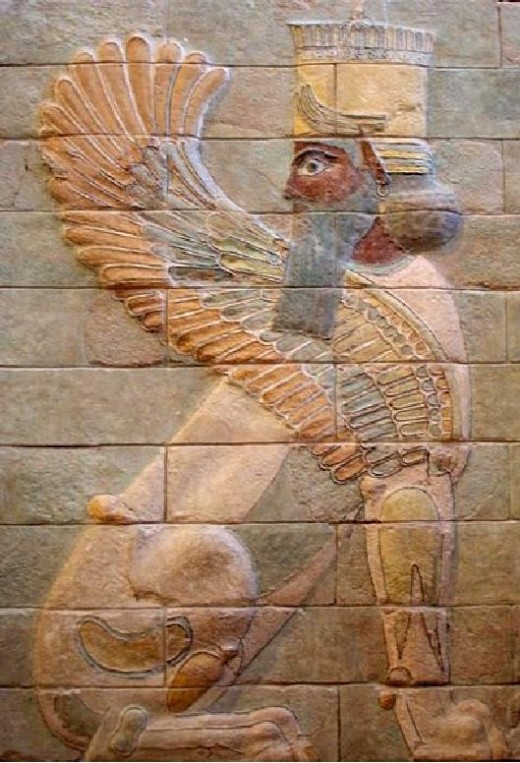

To sum this all up - the vertical side of a right-angle triangle represents one aspect, the horizontal side another, and the hypotenuse is the offspring of the combining sides. The combination of one and another produces a new form of being altogether - a child.
How mad is that? The triangle philosophically represents the mother, father and child.... I wonder where they really got that idea from - given that here our nation's own right-angled-triangle actually has produced a hermaphrodite child, with WINGS and a TAIL? Clearly, I believe the ancients of all lands knew about the British angle as well as the angel.... a word which comes down to us via Latin angelus and Greek aggelos - both from the Hebrew, and meaning one going or one sent; messenger.
The triangle theme was mega-important, and very prominent in Celtic culture. We see it surviving still in the form of the triskalion or triquetra, and various Celtic knot motifs.
Such a trinity of moving-energies represents action, cycles, progress, revolution, competition and moving forward - combine (as they did) these symbolic-representations and their inner-meaning with our gigantic-infant in the land and quite a meaningful image begins to take-form in the mind's-eye, doesn't it? The combination of these motion and triadic attributes, lead to the conclusion that this symbol tells a story of forward motion in a quest....
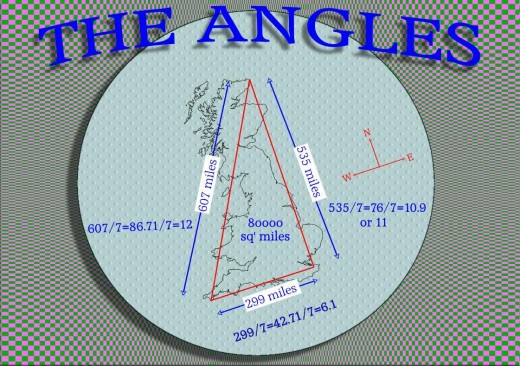
I reckon this vibration emanating from the triangle and the hermaphrodite angel within it explain a lot about the Anglish People, their history, character, drive, spirit of adventure, and the lush beauty and fruitfulness of the land - I really do. I think I understand why the ancients venerated the land.
But of course, 3 and 40 aren't the only digits to emerge from the triangle's measurements - there are also 6, 11 and 12 (not to mention the 7's). A brief look at their meaning won't hurt - the short-line at the base of the triangle first, because it's two trinities - 2 x 3 = 6.
6 has Venus as its ruler, it represents harmony, balance, sincerity, love, and truth. 6 reveals solutions in a natural, gently-unfolding way. 6 is a number of diplomacy in sensitive matters. The spiritual uses of 6 move us toward enlightenment; illuminating the path when in need of spiritual/psychological balance. 6 feeds our compassion and chooses forgiveness over resentment or anger.
The 'upright' line of the triangle vibrates to the number 11. 11 is a 'power' number in which the attributes of number 1 are doubled. The 1 is new beginnings and purity. When we see this digit doubled as with the 11 - then these attributes double in strength. The 11 carries a vibration of balance. It represents equality of the sexes. It contains both solar and lunar energy simultaneously - yet keeps both in their perspective individualities - 11 is perfect balance.
The hypotenuse or diagonal resonates to the number 12 - the months in a year, the signs of the zodiac. 12 of course breaks down 1 + 2 = 3 - the trinity appears again.
Easter Bunny
But on with the topic in hand - Equinox and Easter - Easter being the only 'moveable-feast' still in existence - it happens on a different date each year. It always comes on the first Sunday after the Aries/Libra Full-Moon - the Sun in Aries opposed by the Moon in Libra. Although we have been taught to associate the whole thing with the crucifixion and resurrection of the Pisces avatar, a man, originally Easter was very, very female oriented. The fact that Easter's timing is set by the moon, which is female, is a clue. And so is the egg - eggs come-from females. Eggs are life in seed-form.
Any road, the woman's name, Esther is based-on the goddess' name, variously spelt Oester or Eostre, and the rite of easter is dedicated to her and her eggs.... she gave her name to the female, egg-producing hormone, oestrogen - her sigil or emblem features a rabbit (or hare) jumping over an egg.... so that's where it came from. The Romans called the goddess of Spring Verna, and that's why it's called the Vernal-Equinox - that's Oester's Equinox - female.
Eástre (1909) by Jacques Reich
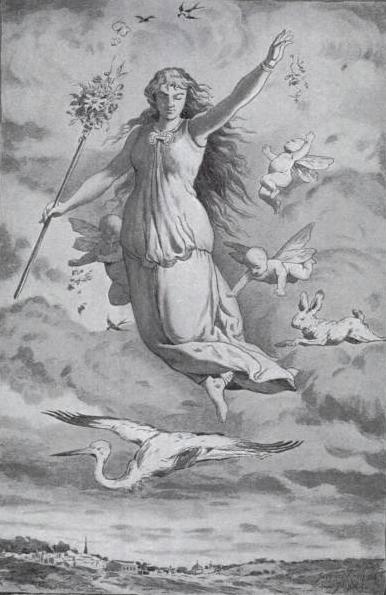
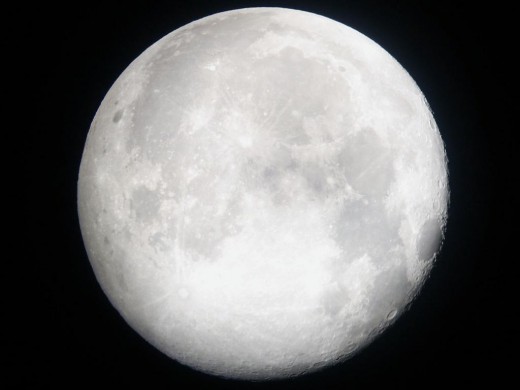
Oester / Eastra (Verna) was a beautiful, playful goddess who reigned in spring, when the Sun King journeyed across the sky in his chariot.... Eastra would come down to earth as a beautiful maiden with a basket of decorated, coloured eggs. Her companion the rabbit accompanied her as she brought new life to plants and flowers by hiding the eggs in the fields. They also placed eggs in tombs or fresh graves, to assist the rebirth of the occupant - the egg represents immortality. The egg is the World Egg, laid by Eostre and opened by the heat of the Sun God. The World Egg hatching-out each year after Spring-Equinox is or was a festival of both Sun and Moon.
The hot-cross-bun is not as Christian as you might suspect. Originally the round bun represented the Moon, with its four-phases or quarters represented by the cross. Christianity borrowed the idea and said that now the cross represented the crucifixion cross. The buns were deemed to be powerful talismans that could ward-off evil, so after Good-Friday they'd keep a few buns back and hang them in-doors over the mantle-piece - fishermen would carry them in their boats for protection. And the Moon is concealed within the Equinox - the word. Equinox comes from Latin 'equus', meaning, level and equal, and 'nox,' from 'nox noctis', night, equal-night, referring to the equality between day and night, male and female at the Equinox - day and night are exactly equal. But there's another meaning - 'equus' is also Latin for horse, steed or mount. So we get the horse of the night, a night-mare, which is not a bad-dream but the Moon (as the Sun is the horse of the day).
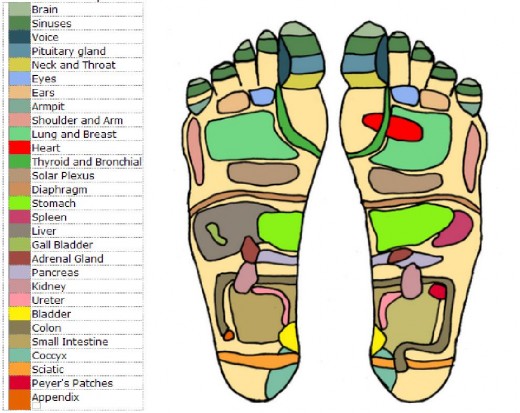
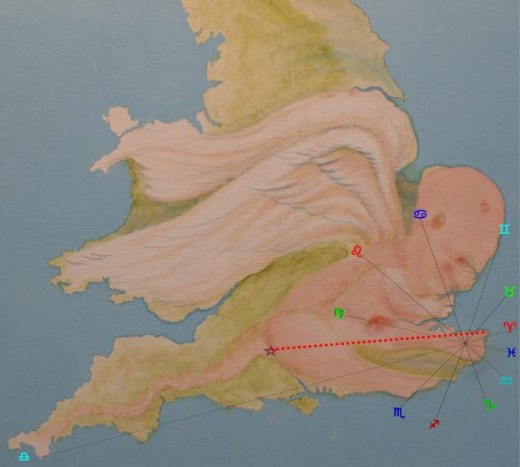
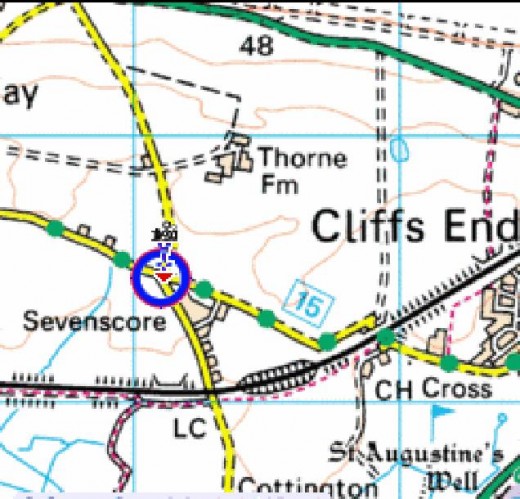
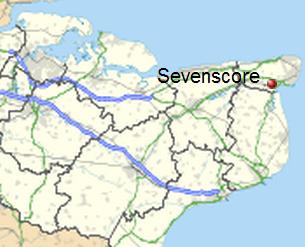
If you observe from Stonehinge - in the weeks prior to the Equinox the Sun rises in alignment with the village of Eastry (named after the goddess of eggs), but at Equinox it is rising directly over the (former) Isle Of Thanet, our cherub's big-toe - and as you can work-out from my diagrams, it rises over the same big-toe as viewed from the cherub's ankle-joint, Canterbury. But - I hear you say - Aries isn't the sign of the big-toe, is it? Aries is related to the head, forehead and brain.
Well... yes, Aries is indeed the sign of the forehead and brain, not the big-toe. But that's not a problem at all, because in the 'alternative' therapeutic art of foot-massage and manipulation - reflexology - the big-toe corresponds to the forehead and brain. What are the chances of that, eh?
I've got another spot of number-bashing here - the isle is full-of-it. As you drive on to Thanet on the Thanet Way, heading towards Ramsgate you pass along the edge of Manston Airport, and halfway along that road there's a side-road that branches-off that leads to the little settlement called Sevenscore.
Seven Score is a number, innit? A score is 20, so seven score is 140. Hmm... have a guess how many miles it is from the Stone Hinge to the Isle Of Thanet? Yes, it's seven-score miles. In particular, it's 140 miles to the underground, prehistoric temple in Margate, on the island.
We'll have a look at that in a minute, but those digits show-up on Thanet in other-ways too. For example when it was an island, it was 4x10 miles in circumference which gives us some-of those digits again - 4 x 10 = 40, of course, and 40's all to-do with a babe in the womb, and the ritual-calendar, as mentioned earlier. On the island is another St Augustine's Abbey, built a couple-of centuries back to mark the spot where St Augustine preached his first sermon in England. And from Augustine's abbey in the ankle of Canterbury, it is exactly 2 x 7 miles east to the one on Thanet, so there are those digits again, 14.
Not only that, the 1 and the 4 are THE numbers associated with the first sign of the zodiac, Aries. 1 because Aries is the first sign (the magician in tarot) and 4 because the fourth arcana represents Aries.
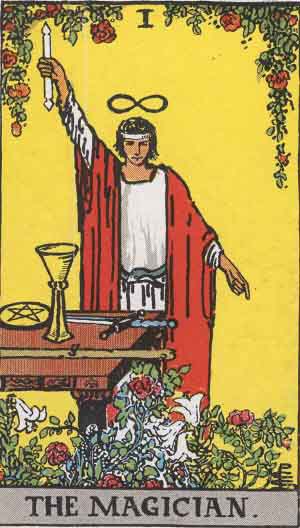
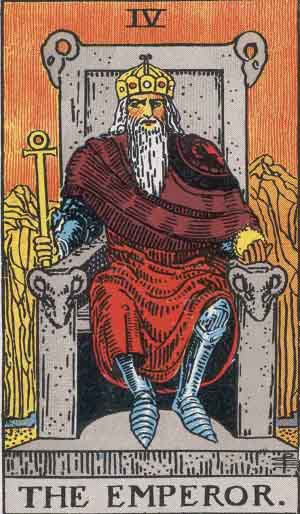
Temple
During the Second World War a German raid on Thanet hit Trinity Church Margate, destroying it utterly but disclosing beneath its ruined altar the access tunnel to an ancient - and forgotten -temple, cut into the chalk by our prehistoric forbears.
Local historians of an orthodox-bent (un-thinking) have described it as a 'Victorian-grotto,' or something meaningless like that - but locals describe it (those that know of it - not many) as Vortigern's Temple, considerably nearer the mark, I'd say. The fact that in later-times they built a church directly over the site - placing the new altar over the old 'altar-room' in the tunnel, suggests at the very least that it had 'sacred' connotations to our ancestors.
It is aligned along its long-axis north-south but I'd bet a million-quid they were facing the Sunrise (east) when they used it for rituals.... I believe that it's designed to encapsulate and represent the Solar-year, so the 'serpentine-path' is a graphic-representation of the Solar-Ecliptic. The 'rotunda' is positioned along the pathway after a 'bend' in the path - Winter-Solstice, and before a 'bend' in the path - Summer-Solstice. The rotunda with its egg-shaped, domed ceiling is the over-arching tent of the heavens, and the egg of the goddess Oester.
This temple encapsulates the male and the female aspects of Creation in one design, is a three dimensional representation of the rams-head of Aries and the solar/lunar festivals of the Spring Equinox and Easter.
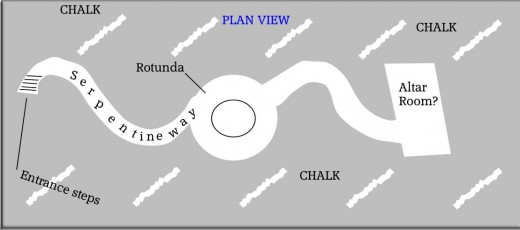
The short sides of the altar-room are exactly half the length of the long sides - a 2:1 ratio.
Oh yes - and from the top of the entrance-steps to the altar-room back-wall, is 104 feet!
There are numeric references all over this former-island, as I said, but I'd better tell you a little bit about the place, before we get-into that.
How It Looked
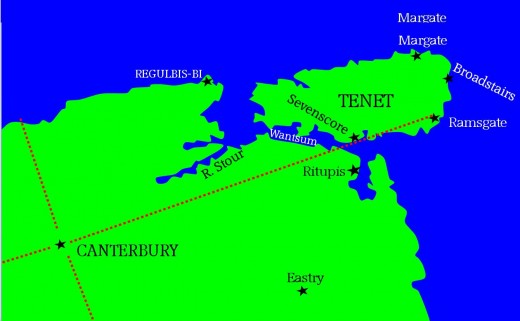
The Isle Of Thanet is no longer, physically speaking, an island. It used to be separated from the main-land Kent by the tidal Wantsum Channel - well, THAT silted up some centuries ago and no-one bothered to dredge it. So there it was,gone. According to the Venerable Bede - (the Ecclesiastical History of the English People c.731AD) - Wantsum was written Wantsume in Olde-English, or Vaxtsumus in Latin. And that's a name that denotes a certain emptiness: the prefix 'vax' doesn't correspond to any Latin I know-of, so 'vax' must be meant as 'vaco': to be free from; empty, devoid of; while the suffix 'summus' is Latin too, 'summa' total number, whole, essence, gist, and here at the Wantsum it's 'summus' - highest number.
Of course, seeing-as this is a channel that was regularly emptied-out when the tide went-out, the name makes perfect sense, in that limited sense - but - given that this isle is or was associated with Eostre and Verna (Roman name for the goddess Eostre) and SHE'S associated with eggs.... then maybe it was the contents of an egg they were referring-to? The egg is empty?
The roughly crescent-shaped channel was 2 miles wide in its heyday and you had to use a boat to get to the isle of Tenet, as it was known, back-then. Consequently, for much of its history it was a virtually empty place, populated only by dead kings, shamen and holy men - the more-or-less egg-shaped isle was universally regarded as a sacred place and was rarely visited by the living except on particular holy-days - around Easter.
And it makes sense (to me) that the ancients wanted the island kept that way - an empty egg.
Thanet was named as Taniatide in the 7th century Ravenna Cosmology ♣ Venerable Bede referred to it as Tanetos Insular c. AD730 ♣ Asserius Menevensis labels it Tanet c.900 ♣ Domesday Book in1086 calls the isle Tenet ♣ Simon Dunelmensis names it Tened in 1164 ♣ The Saxon Chronicle has it as Tenet in the Twelfth century ♣ Thorn calls the island Thanet in 1390.
But I'm going-along with Bede and the Saxon Chronicle - Tenet - and a tenet is a rule, belief, principle or doctrine that's generally regarded as self-evident and true - such as a religious doctrine for example. Tenet also has numerological connotations - in our old way of speech and writing, it was also how we wrote in words the number ten (10). Hmm, that's sort of interesting - the island measured 4 x 10 miles, so there's that number again, 40. So... it's an island associated with numbers and doctrines..... separated from the mainland by a channel of water named Vaxsummas or empty of high numbers - it's all rather intriguing, this numbers thing.
But Tenet's number 10 also relates - physiologically speaking - to the feet for as I've said, Tenet is our landscape-entity's big-toe - there are ten toes. The big-toe is the 'boss' or 'head' of the other toes, number one or number ten (Aries is The Emperor in Tarot - the one that makes tenets).
In pre-Christian days, the island was full of huge, egg-shaped tumuli - burial-mounds - that the kings and high-class folks were lain inside. There were more on this egg-shaped island than there were at the Stone-Hinge. And because the island is completely made-of chalk, the tumuli were made of chalk and could be seen from miles and miles away. There are none there now. Not a single one. Too close to Canterbury, you see. And too close to those history-hiding Christians that took the place over.
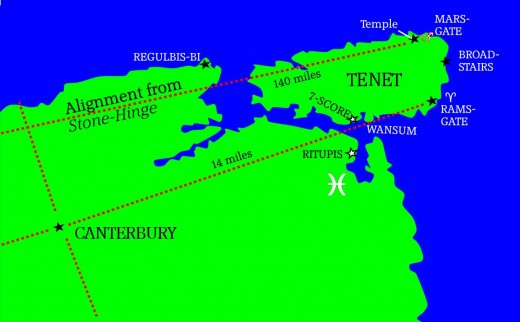
So, from where I stand it looks to me like Ritupis at the southern-end of the channel, and Regulbis Bi at the northern end, represent 'pillars' or 'gates' of the planets through which, at Equinox-Sunrise, the Sun - viewed from The-Hinge AND The-Ankle, majestically, gloriously, crowned in rays of light, rises... flooding the sleeping-kings in their gleaming white eggs on the line of the horizon with this very-special, equinoctial light - the resurrecting-light of the immortal Sun-God flooding through the Mortal World, bringing back to life all that it touches - all that was dead will rise again.
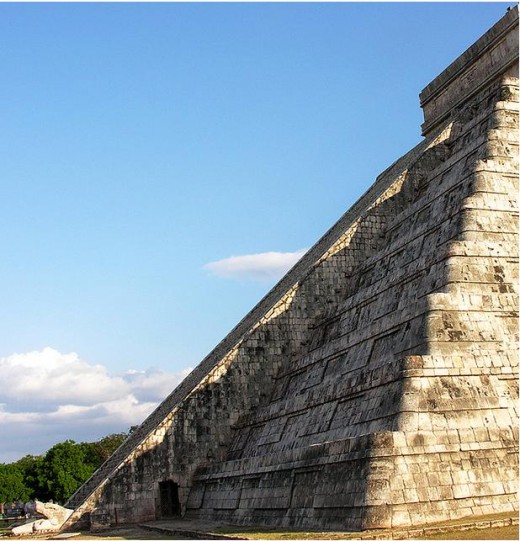
In Ramsgate (gate of the ram) is the parish called Pegwell - a 'peg' is a post or pillar - a gate-post.
In Margate (gate of mars) is the parish of Kingsgate - the 'king' being the resurrected Sun-God.
And as you can see from my nice-picture, these 'gates' happen to be in alignment with the towns Margate and Ramsgate..... and between them Broadstairs. Clearly (to me) these are astronomical or astrological place-names, huh? Course they are. Aries is the sign of the Ram, and it's ruled by the planet Mars... so, given that the Sun rises between these two towns at Spring-Equinox which is indeed the gates through which the Solar-Year and all that light and life enters our world, our lives. And of course, it rises up the Broad-Stairs, in between the gates of Mars and the Ram. It's a symbolism that's pretty-well global, innit?
The Kulkulkan Pyramid in Mexico at the spring equinox the sun projects an undulating pattern of light on the northern stairway - caused by the angle of the sun and the edge of the nine steps that define the pyramid. These triangles of light connect-up with the stone-carved snake heads at the base of the stairs, looking very-much as though a massive serpent snakes down the structure to the earth - symbolically impregnating the goddess. There are nine (9) big-steps plus the top-platform making ten big-steps; and ninety-one (91) smaller-steps between the 9 large-steps - and 9+1=10.
Which takes me back to the underground temple in Margate.
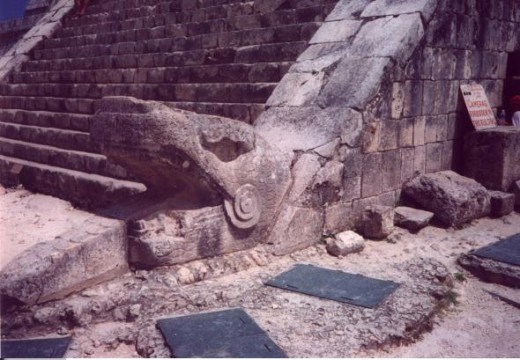
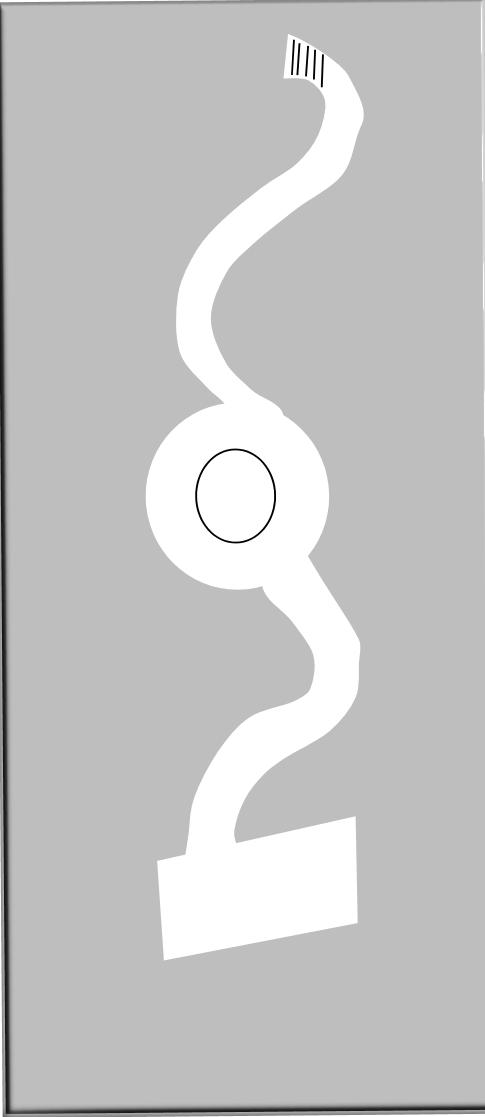
If we stand above the temple and look from the southern end of its axis.... now the layout of the temple look like it's actually a 104-foot serpent. Wow..... the 'serpent' enters the rotunda or 'egg' which is the Sun and Moon, then after being vitalised within the egg, picking up some life-seeds, the serpent exits the egg and descends to the rectangular box at the bottom - the womb of Mother-Earth. I also like to think that the rectangle is the rectangular-shaped isle Thanet.
The stairs up which the Equinoctial Sun rises, Broadstairs, has another name too - the motto on the town crest is Stella Maris, which means The Star Of The Sea, an epithet of the Great Goddess, Isis. Osiris' brother, Set, 'rent the body of Osiris into fourteen pieces and scattered them up and down the length of the Nile' - so that the crocodiles might eat them. His grieving wife, Isis, piece by piece recovered the scattered parts. Whenever she found another fragment, she conjured the 'likeness' of Osiris’ whole body and caused the priests to build a shrine and perform the funeral rites. One vital piece Isis couldn't find - the fishes had eaten it. So by magic Isis made a golden penis and then Osiris was complete. Isis became pregnant.
Osiris and Isis with their son Horus formed the original Holy Trinity upon which all other trinitarian religions are probably based. In this original trinity it was ‘father, son and holy mother,’ which irked the Christian’s for some reason and caused them to replace her with a holy-ghost.
The parable about Osiris was - as far as anyone can tell - the original resurrection story too. And finding reference to the goddess Isis at Broadstairs (Stella Maris), on this island that's tuned to the Spring Equinox and Easter, suggests quite strongly (to me) that the ancient Egyptians also set the timing of that original death and resurrection story at Spring Equinox - and that confirms beyond doubt that all of these ancient religious ideas are indeed allegorical-tales about the Solar-Year.
Now... with reference to that number..... Osiris was cut into 14 pieces and, as we've seen, those particular digits seem to be encoded into the island in a number of ways. But there are other numbers here too.
It seems, on a closer inspection, that the island is covered in numbers that relate to Aries, first male sign of the zodiac. In Birchington there's an Alpha Road - and there's another one in Ramsgate. Alpha is the first letter of the alphabet, and the number 1 - it corresponds to Spring-Equinox and the first sign. There's also a farm in the middle of the island, it's been there for centuries - it's called Hundreds Farm... A significant area of the island was occupied by another large agricultural estate, and it's called Twenties. Twenty - you'll recall - is a score, and a score is a female number.... based on a multiplication of the primal female number, 2.
Within the limited time-span of recorded history the Isle has been a conduit or doorway for at least three culture-changing visitations:
1: Caesar allegedly attempted to land on the island but the Briton’s had prepared wooden stakes (pegs) against him and the beach was a death trap. He landed to the south - at what is now Richborough – in the area designated Pisces, the fishes.
2: The Saxon’s allegedly occupied the island and used it as an easily defended jumping off point from which to pillage the rest of the UK.
3: St. Augustine preached his first sermon on the banks of the Wantsum at Minster.
The constellation of Aries is made up of three points of light that form a triangle that is the head of the ram. These correspond to the three main towns on the island, Margate, Ramsgate and in between them, Broadstairs. Interestingly - of the twelve constellations, Aries is the only one that exists as a separate ‘island’, separated from Taurus and Pisces by what is called the ‘sea’- exactly as Thanet was once separated from the mainland by ‘the sea’.
On another matter of trinities.... on and close to the isle are three place-names that give a big-clue as-to how this island was viewed by our forbears - they saw it as a portal or entrance way to the Otherworld. There were three trees viewed with special reverence, fear and respect - these are the oak, thorn and ash. There's a village called Ash, a hamlet called Acol (Oak-Holt) and near Sevenscore the hamlet of Thorne.
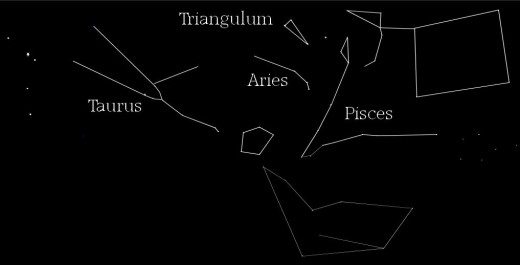
trinity of trees
In folklore the oak, ash, and thorn were gates or portals leading into the world of the fairies - the hawthorn as the “hinge on the door” became the guardian and protector of the entrances to the oak and ash doors - unless hawthorn allowed you access to these doors, the world of fairy remained closed to you, invisible.
The Romans had a goddess associated with hawthorn called Cardea - she presided over marriage and childbirth - hawthorn has always been associated with fertility, and still today in Mayday rituals its blossoms are used to symbolise love and union. She was also known as the White Goddess and was the mistress of Janus who guarded doorways and portals, as such she became known as the 'hinge of the door of the year.'
The ash-tree is a protective spirit, sacred to Thor, Woden and Mars - Woden (Odin) was Thor's father, and he was crucified on an ash-tree. You can see that Ash village is very near to the Piscean temple of Ritupis and the settlements and hamlets of Coldblow Cross, Stonecross, Chilenden (chill-ending) Woodneborough (Woden's Burgh) and others nearby, with similar meanings.
Anyroad, placing ash-berries in a cradle prevents a child - they say - from being traded-in for a changeling by mischievous fairy's – the ash keeps serpents away too (they're scared of it), and protects you against their poisonous bite - Pliny wrote 'that if an adder be encompassed round with ash-tree leaves, she will sooner run through the fire than through the leaves.'
The oak is a cosmic storehouse of wisdom.
Ancients revered oak for its endurance and regal presence, and wearing oak leaves on your head was a sign of high-status among the ancients of many nations - the power of the oak was thereby recognized and honoured.
Numerous writers have traced the name 'druid' to duir, the Celtic word for oak. More precisely and more relevantly though, the actual translation of 'duir' is door .
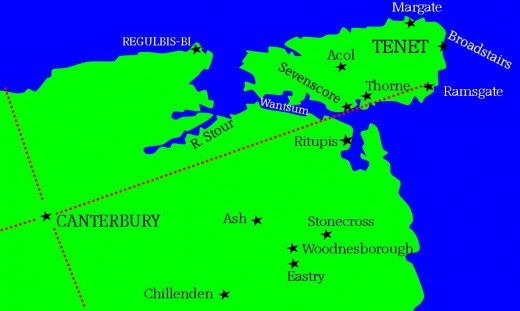
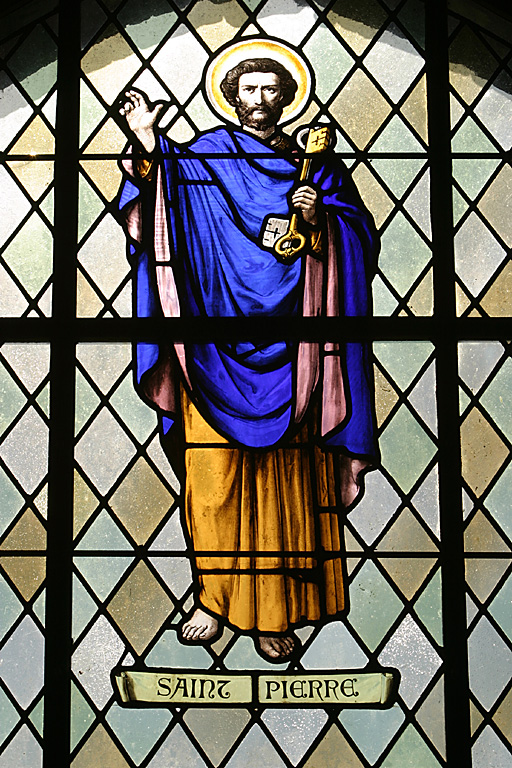
Continuing with the idea that Thanet was seen as an 'entrance-door' or 'gate,' in the town of the ram's gate, that is, Ramsgate, is the parish of St Peter's... and St Peter, you'll no doubt be aware, is the saint who holds the keys to the gates... of the three-worlds. There's even a parish in Ramsgate called Durlock, which is the actual lock into which St Pete puts those keys. In our olde tongue 'dur' -like the Celtic duir, means door, and lock means what it looks-like - lock.
It's been said and written by various investigators that in the ancient-view of things, this island was known as The Isles Of The Dead... for various well-founded reasons - one of which was the massive population of dead kings and nobles and their numerous, chalk-white burial hills all over the landscape here. It's thought that fires were lit upon their tops ensuring they could be seen from as far away as France.... the name of Thanet before the Saxons renamed it, was, according to the experts,Tanarth, meaning - they say - high fire... and Aries is the primal fire sign.
At the gates to the Netherworld
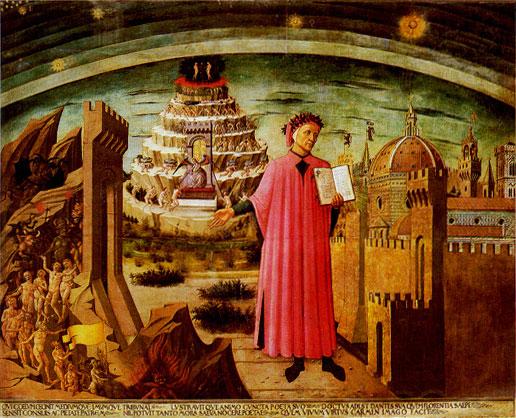
Rossetti

Final Resting Place
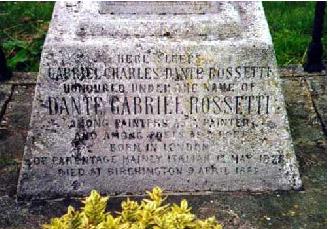
So I want to suggest that - tuned as the isle is to the resurrection of the Sun at the Vernal-Equinox - that rather than characterising the isle as the Isles Of The Dead those who interred their monarchs and nobles here considered it a place of resurrection from the dead - and placing their kings here was sympathetic magic.
The great-and-the-good still occasionally opt for Thanet as a good place to end one's sojourn on the planet, and perhaps increase the chances of resurrection. The co-founder of the Pre-Raphaelite movement, Dante Gabriel Rossetti who named and modelled himself on Dante Aligheri - author of The Divine Comedy - spent the final years of his life in Birchington, and is interred on the island.
His hero Dante Aligheri attributed nine levels of damnation to the underworld, which he called the nine circles of hell. This is of some significance because in The Divine Comedy, Dante goes on a trip into the underworld on an easter weekend - and namesake Rossetti chose to die and remain here. At the very-least this suggests that Rossetti somehow 'knew' that Thanet has an 'association' with Aries, Easter and Equinox - the portal from the Underworld.
Thanet and the villages, hamlets and settlements (and their names) round-about seem to have impressed Rossetti with their echoes or similitude to the features Dante described at the entrance to the underworld in the Divine Comedy.
An example of this would be that, to get to the Underworld the spirit of the deceased employed a ferry-man called Charon to transport them there, across the River that separates the world of the living from the world of the dead - it is said to wind around the underworld nine times.
On the River Stour is an inn and hotel and moorings to which dozens of small-boats are attached. In days of yore if you wanted to get to the Isle Of Thanet this was the place to get aboard the ferry. But it's the name of the place that must have got Rossetti... it called Grove Ferrry - and when you realise that 'grove' is the origin of the modern word for the grave, and put that together with the boats.... we've got the Grave Ferry!
On the Wade Marshes is Potten Street - a mile or two from Dante's final-resting place - and there's a junction on Potten Street, and there stands a house that stands on the junction, clearly-marked on the old-OS-maps as Nine Nails. And that's not very far from Snake-Drove.
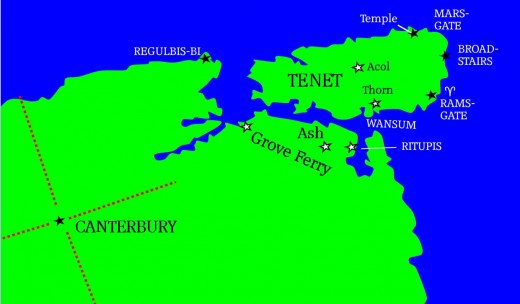
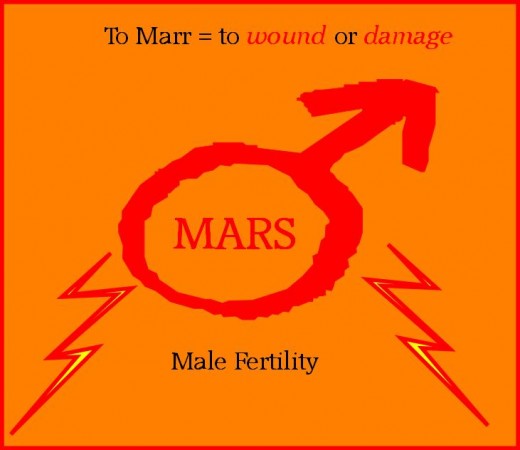
Thanet's Horses
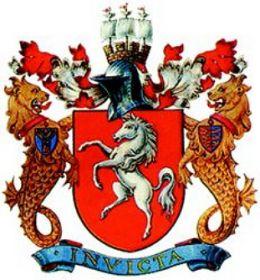
The sound of war
Aries the ram is the primal fire-sign, a warrior sign, ruled by Mars and Mercury. When the Saxons - led by 'brothers' Hengist and Horsa - invaded Kent they came under the battle banner of the rearing-white horse, the symbol we call Invicta. It was on the natural-fortress of the island they holed-up and from here launched expeditions up-and-down the coast. In the Fresian language these 'names' to this day simply mean 'stallion' (hengaest) and horse (horsa )- there is scholarly doubt too that they were even two-diferent-people. The civic regalia of the Island features three horses.
This island clearly has an unmistakable affinity with all things to do with Aries - 'heads,' warriors, and horses - horses were the weapon-of-choice for leaders, and weapons - things that draw-blood - are ruled by Mars. Odin (Woden), the Mercurial chief of the pantheon of Germanic gods - place-named in several ways here - Woodchurch/Woodnesborough, had a magical flying horse called Sleipner.
The island god known as Mannan - after whom the Isle Of Man is named, is name-checked on Thanet too, at the village and airport called Manston - he also had a winged, flying horse and the ability to make pea-shells appear as battle-fleets of ships to scare invaders away. Pysons Road, a major thoroughfare on the isle, means, in AS, peas ('pys' = peas)! And horses - as well as their heads - have been at the centre of Thanet ritual for centuries. Which is odd in itself when you think about it, for islands 2 miles off-shore are not the easiest place to get a horse to in the first-place, especially back-then.
And there's the 'animal in the channel' to consider too - is it a horse or a ram? You don't need an over-active imagination to see it there, its fore-legs in the classic rearing-up posture, as seen on the Invicta. In the olden-days large ships could navigate all the way along the River Stour to disembark passengers or cargo at the little village now called Fordwich.... which was formerly known as Fore-wic. Clearly, the ancients knew of the 'animal in the channel,' and its legs - else why name a village THAT?
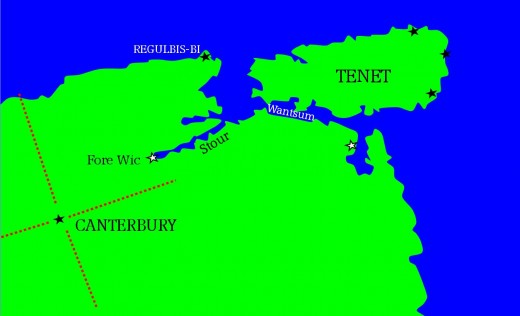
hooden 'oss
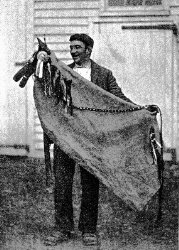
On Thanet are the Hoodeners, troupes of 'mummers' who specialise in parading a mock-horse. They put the head of a horse (used to be a real horses-head) on a pole and wire the jaw to open and spring shut with a loud 'clack.' They then parade about the countryside visiting farmsteads and ale-houses for free cake etc. The practice has been banned several times as 'devilish-behaviour,' and one woman was reported to have died as a result of seeing a particularly fearsome 'hooden-horse.' The word 'Hooden' is Odin (Woden), the 'head' of the pantheon of Anglo-Saxon gods and goddesses; 'hood' is the origin of the word 'head,' and Aries is the sign of the head. In the Kabbalah Hod is the planet Mercury - co-ruler of this sign, the planet of intellect - and that's in the head.
Driving to Thanet along the A299 Thanet Way, about a mile past the Roman Galley pub the road bypasses the hamlet of Warehorn, one of a pair to be found in Thanet, along with the other village more simply called Ware. Orthodoxy will say that a ware is an item or goods to buy or sell - houseware for instance. But knowing about the Aries influence playing its rousing-tunes all-over this zone of the landscape obliges me to look for an astrologically-inclined, non-orthodox solution. Because the simple removal of the "e" from the end of Ware leaves us with war and war-horns.
Just to the east of War(e) and War(e)horn, is the parish of Hereson which has religion-like double-entendres all over it, but I'm going with the immediately appropriate: the prefix 'here' = war, battle, slaughter and 'son' = music, sound.
Of course, the Aries ram's got horns on his head too.
war horns
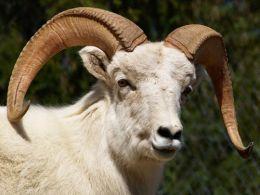
These war-horns are on opposite, north-south sides of the island, straddling the Wade Marsh. As I mentioned earlier, an old country-lane runs across the marsh called Potten Street, from A.S. 'potian,' meaning butt and goad, and just off the A253 near Sarre, meaning sore, is Gore Street, and on the opposite, north side of the island at Birchington is Gore End.
Hugin
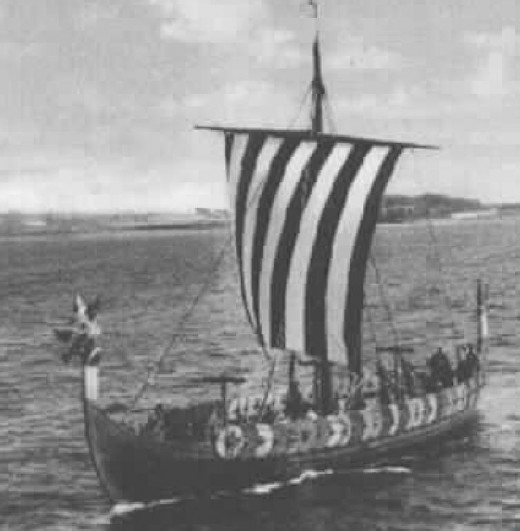
Anglo-Saxon Dictionary
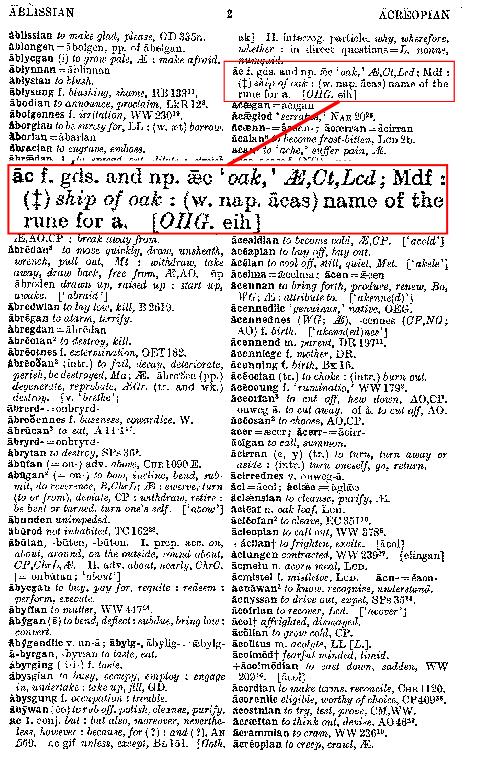
There are quite a few locations on the island alluding more-or-less directly to the Under or Netherworld. There's Nether Court, Hale, Frost Farm and Frost Lane to name a few. We might consider hell or the netherworld a bit... er... warm. But that's only in some parts of it - there are nine levels of hell, ain't there.
Woden, Father of Thor, created the world we live-in by chopping up the frost giants who ruled the netherworld and used their limbs, bones and various other bits and pieces to make the dry land. Woden was nailed to the ash tree for nine nights in agony, and a raven pecked out his eyes. This led to Woden gaining the single-eye of mantic vision and two ravens for company. Woden's ravens were called Munnin (thought) and Hugin (memory). They’d perch on Woden's broad-shoulders cawing advice in his ears, fly-out on secret missions for him, spying on the enemy, seeking their fallen-warriors and so on. One of Woden's ravens reappeared on Thanet in modern times in the form of a Viking longboat, the Hugin, an exact replica complete with dragon’s-head, oars and shields arrayed along its side. It was a gift from the modern-day Scandinavians that the locals wouldn’t have been so keen to see in days long-past. Hugin Road - named after one of Woden's birds - is a residential street in Ramsgate.
The warriors that took over this island looked forward to going to the Netherworld - they called it the 'great-hall,' Valhalla ('val' great, 'halla' hall) - or the shining citadel. You were only admitted through the doors of the shining-citadel if you had slain a suitable number of deadly enemies, and every man felt it his duty and only hope of an acceptable after-life, as a guest in the great hall. On Thanet Valhalla itself is represented at a number of places, at Woodchurch (woad church) and Wood Farm, at Woodnesborough (Woden's Burgh), Wade, Wade House and Hoaden (pronounced oden). The main gate of the hall in Valhalla is described in the sagas as a sacred gate, behind which are holy doors which are so designed that 'there are few that can tell the manner by which they are locked.' As I pointed-out earlier, the hamlet of Durlock at Minster means door lock in A.S.
Woad, or Wad, used to be grown out here on Wade Marsh, planted with spuds, tomatoes and cabbages these days. Woad was a blue pigment painted onto the body as camouflage - it gave the warriors the power of invisibility - powerful magic. Woad smells the same as what the ancient's called brimstone, that's sulphur to you and me, and there is, apparently, a lot of that 'down-there,' in the Netherworld. There's a parish on the island called Bromstone - and that's brimstone unless the vapours have gone to my head. Woad has the recently rediscovered properties - it's antiseptic and coagulant - stops bleeding and sterilises wounds at the same time.
When a warrior had been ritually plastered in woad and turned invisible and reeked like the devil-himself, they said that he had become waden, and to be waden was to become Woden, go totally berserk and run amok among the enemy slaying without fear, nor mercy - the entrance ticket to Valhalla.
Woden/Odin was the ancient archetype around these parts for the multi faceted, lightening-like, talented, inventive, funny, musical, artistic genius within human-kind. The Roman name for this archetype was Hermes Trismagistus - Hermes Thrice-Great, astrologically represented by multi-talented Mercury - Hod in the Kaballa - co-ruler of Aries, dwelling in the forehead.
As I mentioned above, Thorne takes its name from the faerie tree, hawthorn, but - due to the presence of his father in so many Thanet place-names - I suspect the name is also reference to that red-haired, bearded, thundering and hammering god, Thor, the son. A thorn is a threatening weapon employed by a plant for defensive purposes, a natural model for early man to copy. The god Thor is all martian heat and energy, so much so that our word for the spring melt - thaw - is based on his name and qualities. He is the god of thunder - when his hammer strikes the anvil the thunder booms and the ground shakes - this shaking is felt most at Quex House on the island - 'quex' means quakes in Anglo-Saxon. He was the personification of warrior planet mars - which is why Thor was a favourite among the scary Scandinavians, as was his best pal and constant companion, the trickster Loki.
Loki is the Mercurial aspect, symbolised as a distinctly separate entity from Thor, where in Odin his father, Mercury was part-and-parcel of his Being.
Puck, the English manifestation of Loki, is named all over this eastern part of the map, mostly along the formerly much-wider banks of the River Stour, the leg of an animal.... there's Little Puckstone (farm), Greater Puckstone (farm), Plucks Gutter, Acol and Puces - Puces is 'puck's', they just spelled things differently, back then. Acol (oak holt) is at the same-time, also an anagram of Loca, Loci, Loki - other known spellings for Puck the sprite, companion of Thor.
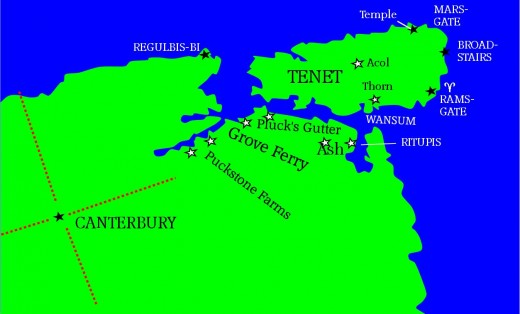
So, athough there's a zillion (or two) pertinent and relevant Aries sign-posts in Kent we haven't investigated, it's time to expand the cone, pan-back. I've put a couple-a pictures below, showing the view from up-here on my cloud, when we continue the Aries alignment from Canterbury to infinity - that being Canterbury actually, 'cos these alignments (and we) are on a sphere - where an alignment starts is where it finishes.
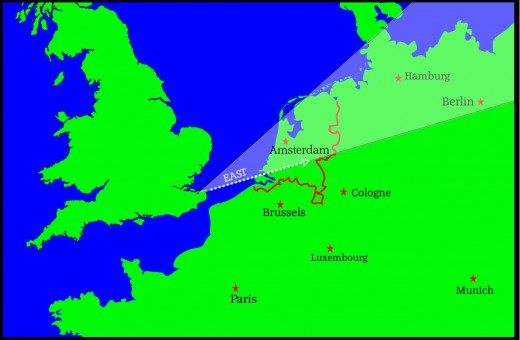
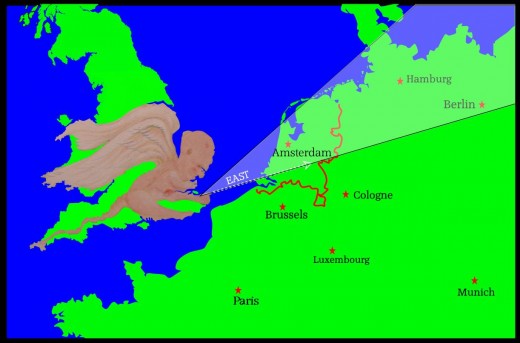
'hol'

Oester Dam
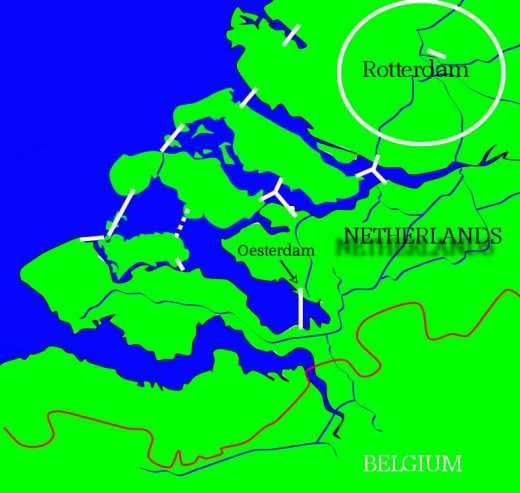
Rembrandt

...to the nether regions
We left St Augustine's Abbey in the ankle of the English Cherub, ramming a channel eastward we crossed the Wantsum Channel - passed through Nethercourt , Hale (hell; hall) Brimstone (Bromstone), between the Gate Of The Ram and the Gate Of Mars, leap the Broad-Stairs and charge horns-first into the equinoctial rising Sun, rampaging across the English Channel our cloven-hooves make their prints on the silty-soil of the Nether-Lands, otherwise called Holland.
I was talking about empty eggs in earlier paragraphs, empty easter-eggs. Well..., the name Holland has the syllable ‘hol’ prefixing its ‘land,’ and that means, if I know my eggs, hollow. And there’s a little-bit more: if it wasn’t for an amazing series of dams the Dutch have constructed, they’d all be underwater, as most of the Netherlands is below sea-level, much of the dry-land is reclaimed from the sea. In fact, it's reclaimed from a large river - the country is built in the mouth of a river estuary - positioned just like the Isle Of Thanet was. The point I'm leading-up to here is merely that one of the dams is named Eoster-dam.
Co-founder of the Pre-Rafaelite Brotherhood Dante Gabrielle Rossetti was interred on the Isle Of Thanet - which I mention because the Netherlands and master-painters are - more-or-less - synonymous. The 17th century was the age of the Dutch Masters - Rembrandt, Vermeer, Jan Steen, etc. In the 19th and 20th century the masters were Van Gogh, Mondriaan and Escher.
From the 17th until the early 20th century, the Dutch had a bit of an empire and a few, highly lucrative imperial possessions, which - in the usual way with empires - they took from the Portuguese, through war. The Dutch East Indies (now Indonesia) was one of the most valuable European colonies in the world - and it all began with trading spices..., pepper to be precise - and pepper is ruled by Mars - all hot things are deemed Martian - including food.
It was all going more-or-less pretty-well making the Dutch very-rich, until January 1942, when the imperial Japanese invaded. After a bit the Dutch put their hands-up in Java, and many Indonesians welcomed the Japanese as liberators - to begin with. The Japanese occupation saw the wholesale dismantling of the Dutch economic, political and social structures, replacing all-that with a Japanese regime.
Dutch Empire
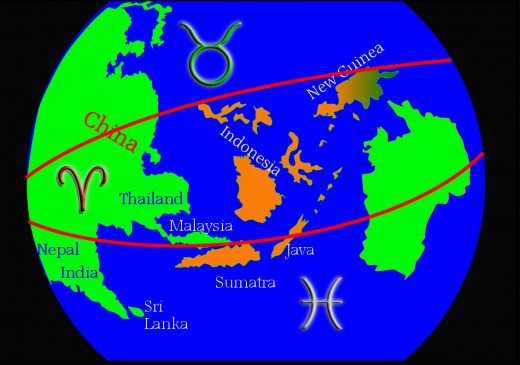
Germany - Julius Caesar was the first to recognize the Germans as a distinct ethnic group, separate from the Celts. As you can see from my diagrams, Germany falls into and is 'influenced' by three zodiacal regions of the landscape zodiac - Aquarius, Pisces and Aries. This combination of signs underlies the amazing fact that 103 Germans have won Nobel Prizes - mostly in physics, chemistry, and physiology/medicine. Historically Germany has been called Das Land der Dichter und Denker (the land of poets and thinkers)... which puts in my mind those ravens - Hugin and Munnin, thought and memory.
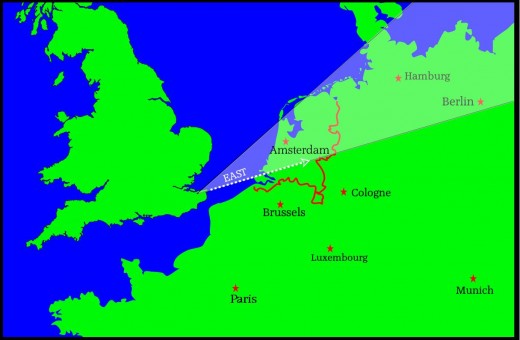
I've put the names of various genius' on the map instead of the more usual and familiar place-names. I think it's very enlightening to see the regions and signs and what comes forth from them, culturally, intellectually, scientifically, artistically etc, etc..
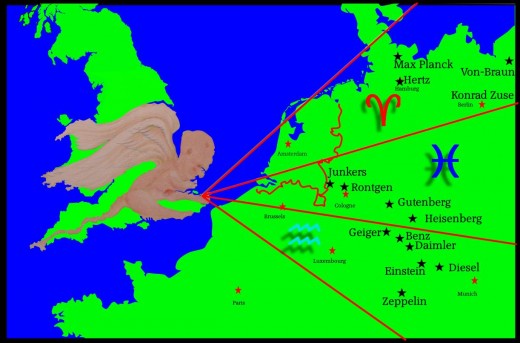
Heisenberg
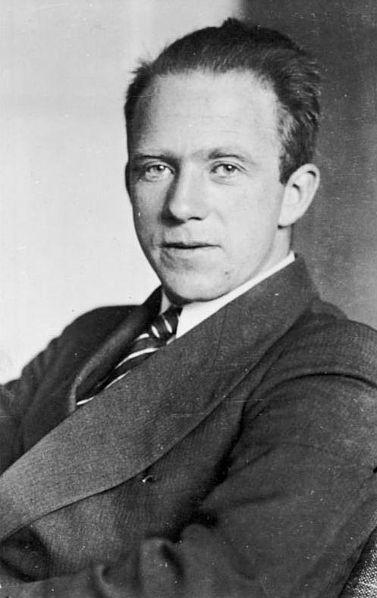
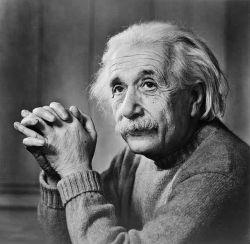
The genius Albert Einstein (Piscean 14 March 1879), from the same geographic and zodiacal region, said: 'Science without religion is lame, religion without science is blind.'
1905 was called Einstein's annus mirabilis (miracle year). He came up with explanations which at the time could not be experimentally proved and many of his theories took a long time to be accepted even among his peers in the scientific community - he is THE role-model of all 'mad-professors.'
In 1905 he published four revolutionary ideas:
♦ An explanation of the photoelectric effect showing that light energy came in chunks or quanta. This changed thinking on the nature of light.
♦ A discussion of Brownian motion demonstrating the existence of molecules.
♦ The nature of space and time.
♦ The dynamics of individual moving bodies.
These last two formed the basis of Einstein's Special Theory of Relativity and led to that famous equation, E = mc2.
The Piscean-visionary that laid the foundation-stones for the Aquarius Age never let ego go to his head, saying: ' whoever undertakes to set himself up as a judge of truth and knowledge is shipwrecked by the laughter of the gods.'
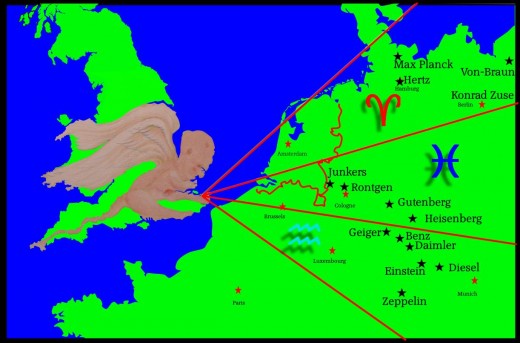
Konrad Zuse

Geiger
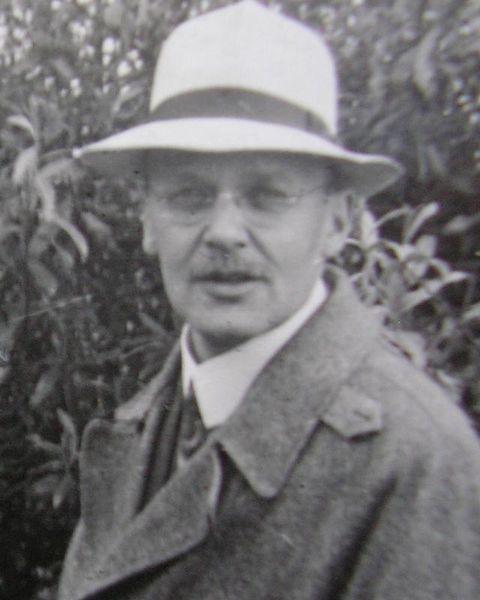
Rontgen
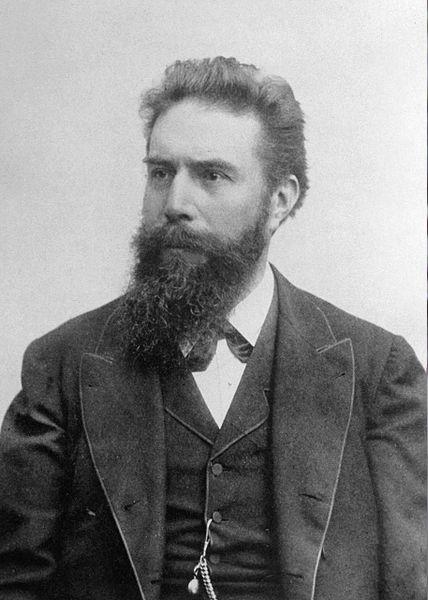
Von Zeppelin
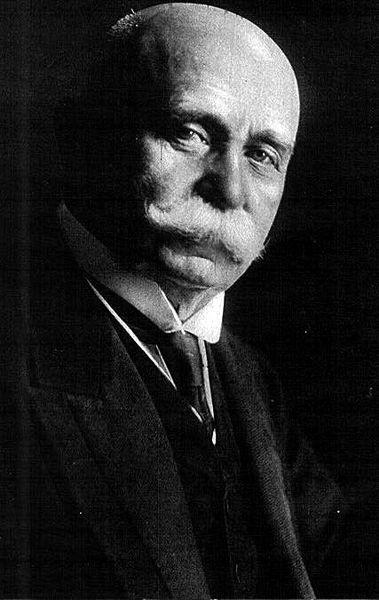
Hans Geiger (Virgo September 30, 1882), co-inventor of the Geiger-Counter, and an experiment that discovered the atomic-nucleus was also born in the Aquarius sector of Germany.
In the Aries sector we have the birthplace of Heinrich Rudolf Hertz, who's work on electromagnetic radiation paved the way for the development of modern telecommunications. Interesting then that Aries is also the home sign of Konrad Zuse, who built the first fully automatic digital computer - the Z3, which he had functioning by May 1941, paving the way for the data-age.
Moving slightly to the south, into the Pisces sector, we find the birthplace of Wilhelm Conrad Röntgen (Aries 27 March 1845), who on 8 November 1895 produced X Rays for the first time. That was handy, they said - here, have a nice prize for your physics from that nice Mr Nobel, which he got in 1901.
Modern transportation as we know it was mostly down-to the German inventors, engineers and industrialists: Von Zeppelin, Otto Lilienthal, Gottlieb Daimler, Rudolf Diesel, Hugo Junkers and Karl Benz. I've put them on the map too - Benz, Diesel, Zeppelin and Daimler were born in the Aquarius sector. I think that's so appropriate - the transportation to launch the Age of Aquarius sprang forth from the land, in the Aquarius region of the landscape-zodiac, spindled in the ankle of the English Angel. Otto Lilienthal (May 23, 1848 – August 10, 1896) was known as the Glider King - the first person to make well-documented, repeated, successful gliding-flights. On 2 July 1900, a Zeppelin (Cancer 8 July 1838) made the first flight over southern Germany. The airship rose and remained in the air for 20 minutes, but was wrecked when landing. The airplane and engine pioneer Hugo Junkers (Aquarius 3 February 1859) is from the Pisces zone. In 1915, he pioneered the change in materials and technology away from wood, fabric and wire rigging towards metal monoplanes with no external bracing. Werner von Braun the German engineer who invented space-rockets hails from Berlin in the Aries sector - Aries is the prime-fire sign, so that figures, huh?
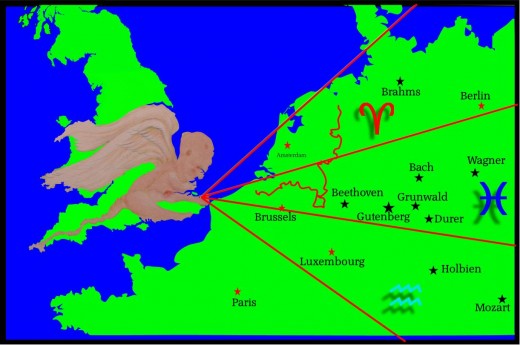
Gutenberg
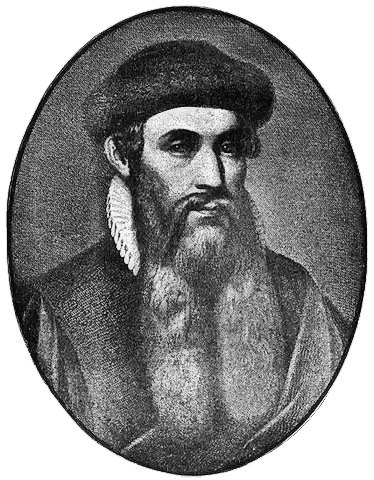
Holbien The Younger
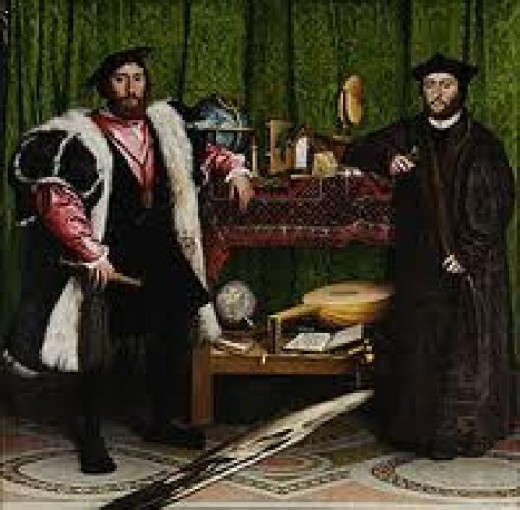
Engraving by Dürer
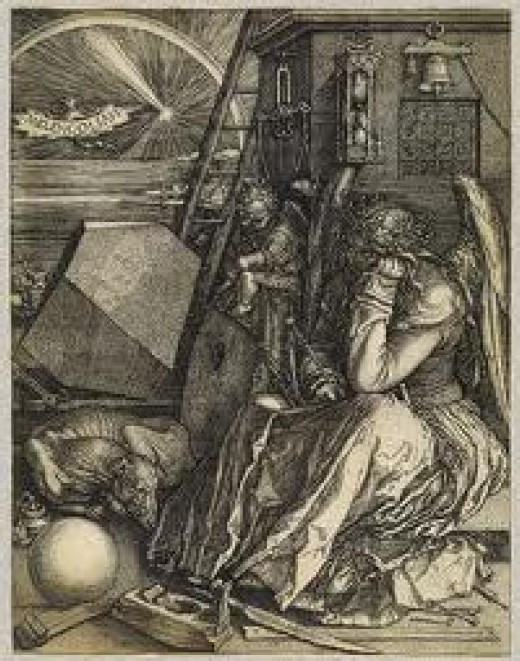
Gutenberg (Aquarius February 3 1398) was a German printer and publisher who introduced printing to the world. He invented mechanical movable type printing - regarded by egg-heads as the most important event of the modern era. He enabled the mass production of printed books which were - for the first time in known history - economically viable for the printer and the readers alike. Without Gutenberg's devilish devices the Renaissance, Reformation, Age Of Enlightenment and Scientific Revolution wouldn't have happened. His mechanical contraption laid the basis for the modern knowledge-based economy and the spread of learning to the masses.
Matthias Grünewald, Hans Holbein and Albrecht Dürer were important German artists of the Renaissance. The Germans have lead the way in virtually every human endeavour toward greater things, ne pas? Given such an illustrious history, it's no wonder that the People of Germany were willing to believe that megalomaniac Nazi bastard when he told them they were the Master Race. And I haven't mentioned the music yet!
The German's have laid the under-pinnings for THAT, too. Classical music composers from this land include Ludwig van Beethoven, Johann Sebastian Bach, Wolfgang Amadeus Mozart, Johannes Brahms, and Richard Wagner. I've made another map with their names stuck on it (above). You can see that the majority of the composers were born in the Pisces sector - but not all of them. For the purposes of this exercise we'll look at the one Master who was born in the Aries region, and that'll be Brahms... ho ho ho - that's Rahms if we lose the 'b' off of his name.
Altarpiece by Grünewald
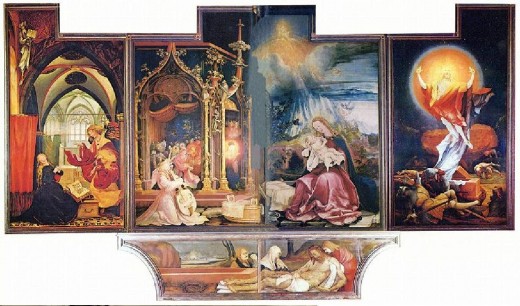
Brahms
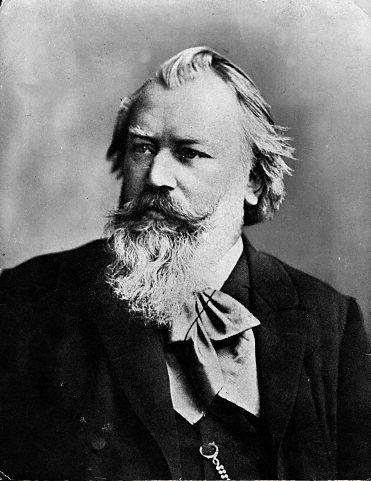
Seminal Sounds
Brahms - ( Taurus 7 May 1833) - German composer and pianist, was one of the leading musicians of the Romantic Period, referred to as one of the '3 b's,' Beethoven, Bach, etc. Many of his works have become staples of the modern concert repertoire - an uncompromising perfectionist, he destroyed many of his works and left some of them unpublished. His music is firmly rooted in the structures and compositional techniques of the Baroque and Classical masters. He was a master of counterpoint, the complex and highly disciplined art for which Bach is famous, and also of development, as pioneered by Haydn, Mozart and Beethoven.
Brahms is almost perfectly representative of the Aries influence in which he was born, because he is considered a traditionalist and an innovator - at the same time. That is pure Aries.
As is the the disciplined, highly constructed nature of Brahms's works - it was a start-point and inspiration for a generation of composers... equinox is the 'start-point' too.
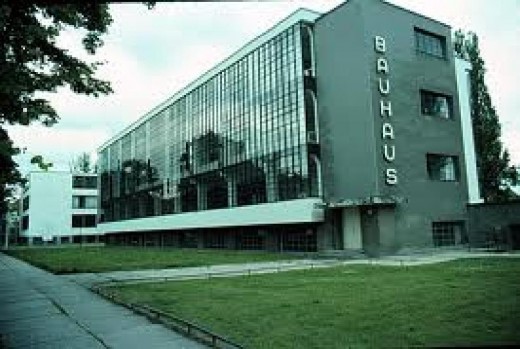
Ludwig Mies Van Der Mies
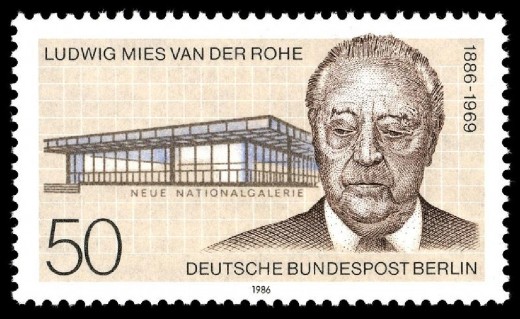
Architecture
Germany was the birth-site of Gothic, Renaissance, Baroque and Bauhaus. Architects from Germany devised the Carolingian and Ottonian styles - precursors of Romanesque. Germany was the main inspirational force behind the early modern movement, especially through the Bauhaus movement.
Ludwig Mies van der Rohe became one of the world's most renowned architects in the second half of the 20th century - he was the bloke that came-up-with the glass façade skyscraper.
Gothic
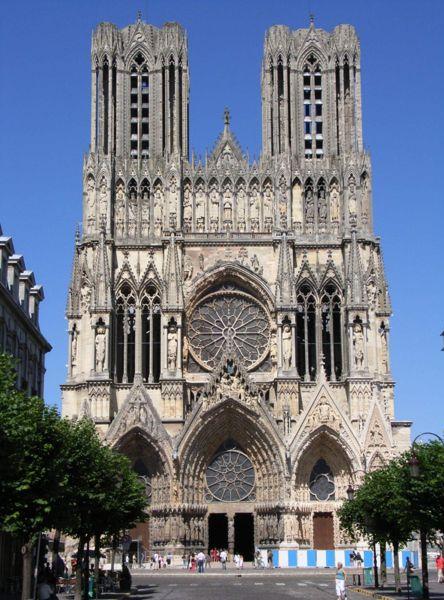
Romanesque
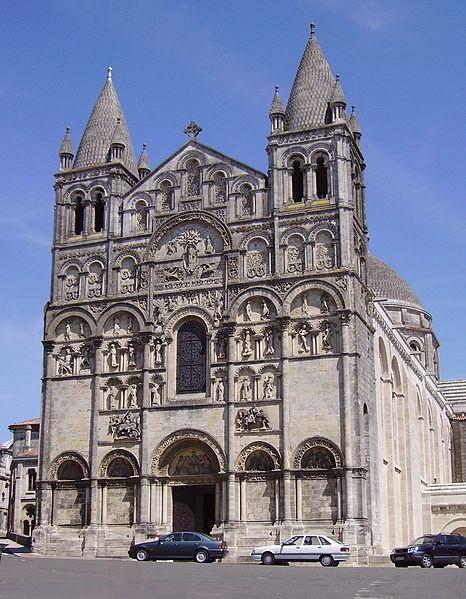
Carolingian
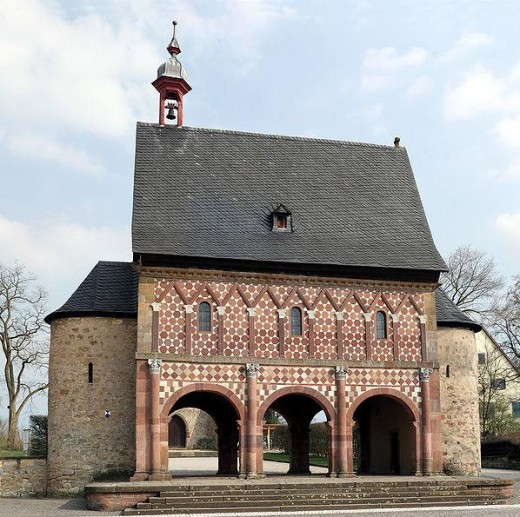
Ottonian
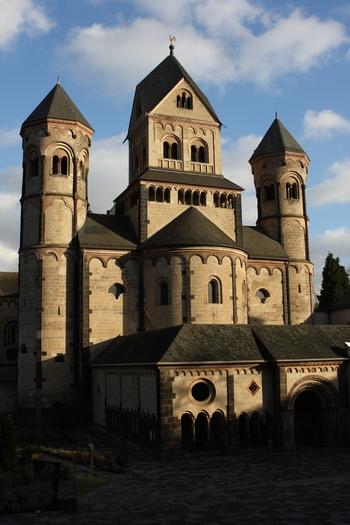
That's about every sphere of human endeavour I think... er..., no it's not - there are a few other areas of human culture that the German's have excelled at and lead the way in - warfare being one of them, both anciently and modernly. But we'll come to that in a moment, after we take a gander at their ancient religion and religious practices.
On Thanet I mentioned the Wodenites - place-names on the isle commemorate Thor and his father Woden/Odin - Hereson (music Of battle), Ash, Woodnesborough, Thorne - and here in northern Germany is where the Wodenites came from in the first-place.
Though we have little by way of written records, there's not much doubt that the Christians would have had a tough time converting the German Wodenites - they'd have had little time for a meek, peaceful hippy like Jesus. The Christians had their terrifying cross but the Germans had Thor’s hammer, Mjolnir. In Scandinavia where there are some records, Thor's hammer was a symbol that united them behind their old gods in the face of the Christian's European spread. I expect that the same happened here - there is the story of St Boniface.
He decided to face Thor and Woden directly - and direct confrontation with the old-gods and their worshippers proved rather dangerous. In 723, St. Boniface cut down the Donar Oak in northern Germany. According to ancient tradition, this oak had sacred ties to Thor. When the thunder god did not kill Boniface for cutting down his oak, many followers of Thor and Woden were converted.
But Thor and his dad had their revenge. Thirty years later their unconverted followers murdered Boniface and 50 other Christians for wrecking their sacred site.
Other missionaries worked in a subtler way. Rather than alienate the locals, they redefined Christianity in Wodenite terms - since they respected might and courage, the wily-Christians turned Jesus into a warrior. Instead of a peaceful hippy, Christ now battled with Satan. He exhibited the warrior qualities respected by the well-hard Germans.
German Coat Of Arms.... Hugin?
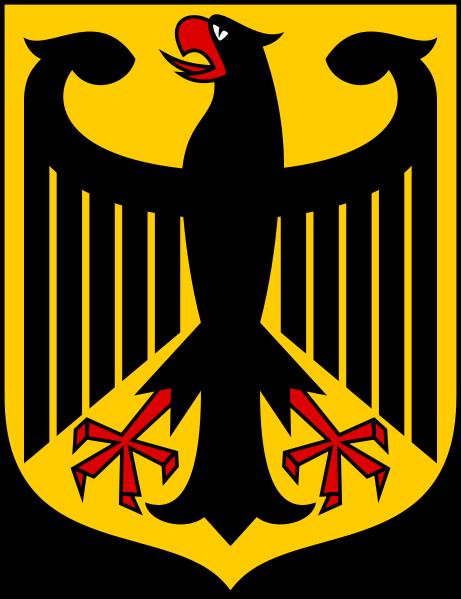
In the Book of Revelations, a warrior Jesus defeats Satan in a great battle. The Wodenites found this more acceptable, since it paralleled Ragnarok (Old Norse 'Fate of the Gods' or 'Twilight of the Gods'). In both story's, the world faces the end with the gods battling evil. In the myth, Woden, Thor, and the other gods die in the battle while destroying all evil. However, the world itself is also destroyed and there are only two survivors. The Christians cleverly seized on this and said that these two survivors must be - were - Adam and Eve in the Garden of Eden.
It appeared to work - Germany represented the most Christianized country in the world by the 1930s and 40s. The People of the Land of Poets and Thinkers were led astray by a dream which became a nightmare. Adolf Hitler - an Austrian - used religious ideas and images to blind the German People to his real nature - and real plans. He pretended to be the German Messiah, and they believed him.
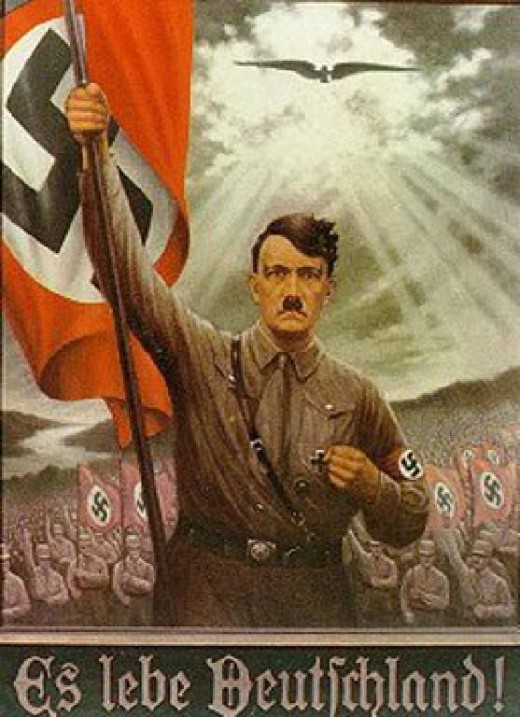
Aries The Emperor
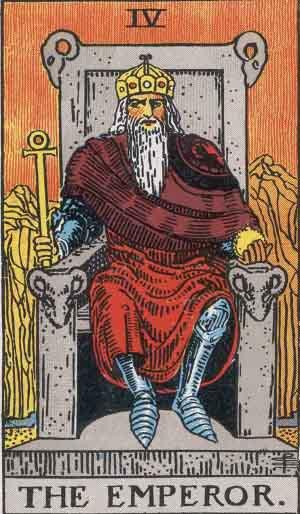
Arien and Aryan
Phillip Wayne Powell: in the fifteenth and early sixteenth centuries, a powerful surge of German patriotism was stimulated by the disdain of Italians for German cultural inferiority and barbarism, which led to a counter-attempt, by German humanists, to laud German qualities.
M.W. Fodor in The Nation in 1936: No race has suffered so much from an inferiority complex as has the German. National Socialism was a kind of Coue method of converting the inferiority complex, at least temporarily, into a feeling of superiority.
Hitler's close friend, Dietrich Eckart, told of overhearing Hitler showing off to a woman by denouncing Berlin: the luxury, the perversion, the iniquity, the wanton display and the Jewish materialism disgusted me so thoroughly that I was almost beside myself. I nearly imagined myself to be Jesus Christ when he came to his Father's Temple and found the money changers.
Nazism advocated the supremacy of the claimed Aryan master race over all other races. Nazis viewed the progress of humanity as depending on the Aryans and believed that it could maintain its dominance only if it retained its purity and instinct for self-preservation.They claimed that Jews were the greatest threat to the Aryan race. They considered Jews parasitic. To maintain the purity and strength of the Aryan race, the Nazis sought to exterminate Jews, Romani and the disabled.
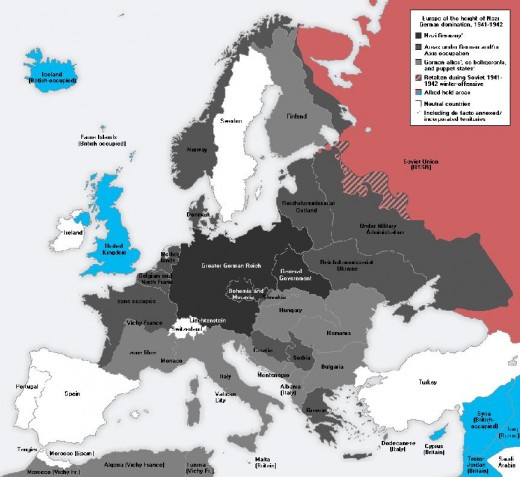
The Nazis set out to establish a large empire in Europe - and they started on 1 September 1939, by invading Poland. Thus began the second world war. As you can see from the map above, they very nearly got their empire.
The war ended with the victory of the Allies over the Axis in 1945. World War II altered the political alignment and social structure of the world. The Soviet Union and the United States emerged as rival superpowers, setting the stage for the Cold War, which lasted for 46 years.
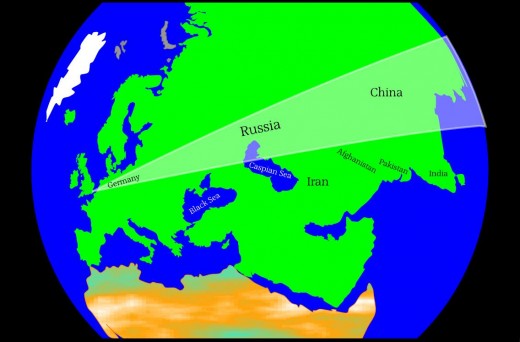
The history of the Russian State begins - according to tradition - in 862, when it was known as Gardariki (realm of towns), centred in Novgorod. They officially adopted Christianity from the Byzantine Empire in 988, and this started the process of the melding-together of the Byzantine and Slavic cultures that defined the Russians for the next thousand years.
I copied the map in three green hues (below) from Wikipedia - it shows the extent of the old Russian Empire at different phases of its history - whew! Look at the size of it. It makes other empires look a bit puny by comparison.
Tsarist Empire
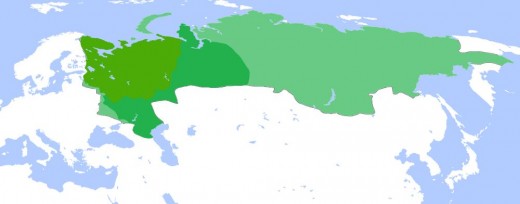
Hugin & Munnin?
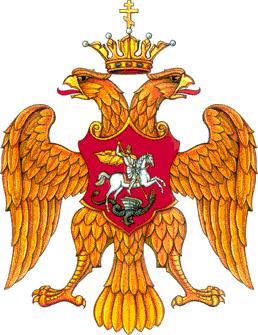
Tsar's Imperial Standard
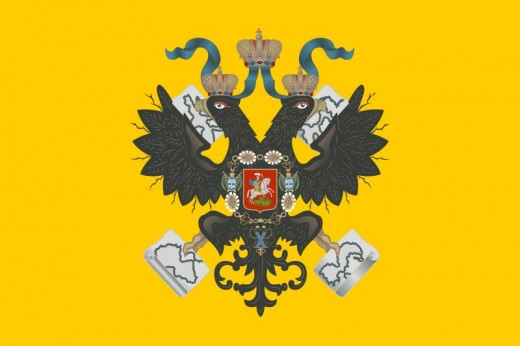
I copied this paragraph from Wikipedia too:
By the 16th century, the Russian ruler had emerged as a powerful, autocratic figure, a Tsar. By assuming that title, the sovereign of Moscow tried to emphasize that he was a major ruler or emperor on a par with the Byzantine Emperor or the Mongol Khan. Indeed, after Ivan III's marriage to Sophia Palaiologina, the niece of the last Byzantine Emperor, the Moscow court adopted Byzantine terms, rituals, titles, and emblems such as the double-headed eagle, which survives as the coat of arms of Russia.
The Tsardom of Russia was the name of the centralized Russian state from Ivan IV's assumption of the title of Tsar in 1547 until Peter The Great's foundation of the Russian Empire in 1721 - which he ruled for 42 years.
Living within the Russian Empire wasn't all it was cracked-up to be.
Wikipedia:
The state required service from the nobility, primarily in the military because of permanent warfare on southern and western borders and attacks of nomads. In return, the nobility received land and peasants. In the preceding century, the state had gradually curtailed peasants' rights to move from one landlord to another; the 1649 code officially attached peasants to their home.
The state fully sanctioned serfdom, and runaway peasants became state fugitives. Landlords had complete power over their peasants . Peasants living on state-owned land, however, were not considered serfs. They were organized into communes, which were responsible for taxes and other obligations. Like serfs, however, state peasants were attached to the land they farmed. Middle-class urban tradesmen and craftsmen were assessed taxes, and, like the serfs, they were forbidden to change residence. All segments of the population were subject to military levy and to special taxes. By chaining much of Russian society to specific domiciles, the legal code of 1649 curtailed movement and subordinated the people to the interests of the state.
USSR after WWII
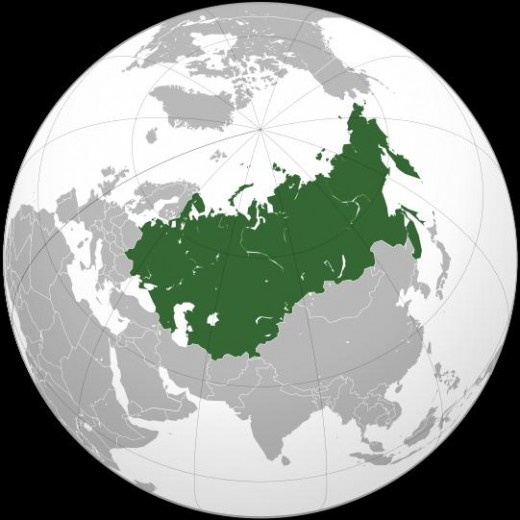
from Lenin
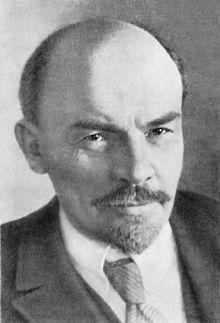
Over the centuries there were many bloody-uprisings and revolutions through which the Tsars still maintained their grip on power and control - until World War I came along. Right in the middle of it they had the umpteenth Russian Revolution, which finally destroyed the Tsarist Autocracy and led to the Soviet Union - supposed to be an empire of workers - but they had Emperors as cruel as any they'd had before.
In February 1917 mass-demonstrations in Russia provoked by the hardship of the first world-war forced the Tsar to abdicate. He was replaced by an uneasy political relationship between, on the one hand, a provisional Government of parliamentary figures and, on the other, an array of 'Soviets': revolutionary councils directly elected by workers, soldiers and peasants.
The Bolsheviks promised the People peace, land and bread - but I don't think they got much of those. The Soviet Union was a single-party state from its inception until 1990. A union of 15 subnational Republics, the Soviet state was a highly-centralized government and economy.
In June 1941, the Nazis and their allies invaded, breaking the non-agression pact, which the Nazis had signed in 1939. After four years of warfare, the USSR emerged victorious. And as mentioned earlier, thus began the Cold-War.
to Gorbachev

The Ten Tenants
The USSR came and went... it 'lived' from 1917 to 1991, a life-span of 74 years, and in that lifetime its head died and was replaced ten times..... hmm. I'm taken back to the isle called Tenet again - meaning the number ten + rules, principles & doctrines etc.
Lenin led the Soviet Union for a couple of years - 1917–1924, until he died, followed by co-revolutionary Joseph Stalin from 1924 to 1953, when he died. He was followed for a brief spell (1953 - 1955) by Bulganin, and then Malenkov (1955–58), who was overthrown by Nikita Krushev, and he was Emperor from 1953 to 1964, when he was overthrown, in October of that year. Leonid Brezhnev took over the throne of the empire presiding over the country from 1964 until his death in 1982. He was succeeded by Yuri Andropov in November 1982, and he was the boss until his death fifteen months later. Chernenko got the job next, but he didn't last too long either - he led the Soviet Union from 1984 until his death thirteen months later, on 10 March 1985. Then it was the turn of Gromyko who lasted until 1988, followed by Mikhail Gorbachov, who served from 1988 until the Soviet Union's dissolution in 1991.
It is now and only now, when in the regions afflicted by the famine there is cannibalism and the roads are littered with hundreds if not thousands of corpses, that we can (and therefore must) pursue the acquisition of [church] valuables with the most ferocious and merciless energy, stopping at nothing in suppressing all resistance.
V.I. Lenin
The Kremlin
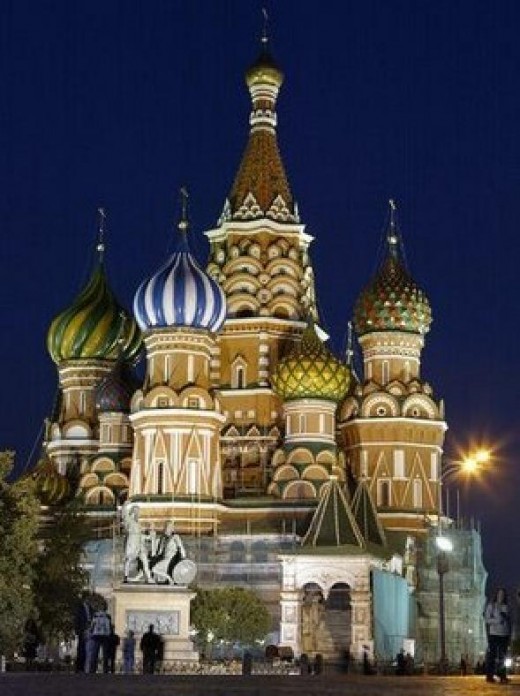
Like the emperors of old, the more recent rulers of Russia ruled by tyranny - deliberate, meticulously planned and executed terror. As soon as the Soviets seized power, they began an almost endless stream of economic decrees and policies. These turned-out disastrously, resulting in a massive famine which killed up-to ten million people, depopulation of the cities by 50%, and a breath-taking decline in their standard of living. According to historians, Lenin repeatedly said that he would let the whole nation die of hunger rather than allow free trade in grain.
Uncontrolled printing of money lead straight to hyperinflation - the Russians had to revert to a system of barter. They nationalised all manufacturing and all retailing, placed price controls on all agricultural products, which the state requisitioned (stole) by force, and the only people who could purchase grain was the state itself. Forced labour (slavery) was introduced for civilians as well as the military.
Trotsky said: It is said that compulsory labor is unproductive. This means that the whole socialist economy is doomed to be scrapped, because there is no other way of attaining socialism except through the command allocation of the entire labor force by the economic center, the allocation of that force in accord with the needs of a nationwide economic plan.
Which is something they didn't have - a plan.
The irony is of staggering proportions - those who had hailed themselves to be the liberators of the workers and denounced their exploitation had now discovered the joys of slavery.
After a revolt in 1918, the troops turned their guns on their fellow socialists, executing 350 captured rebels - while 500 hostages were shot in reprisal in Petrograd. A month later a woman called Fanya Kaplan nearly succeeded in assassinating Lenin. Unfortunately this gave them the excuse to initiate the Red Terror - mass executions of people based entirely on their class origins and beliefs. On September 5, the people's commissars officially legalized the red terror.
From then on the executions never ceased. The number murdered is estimated somewhere between 100,000 and 500,000. The Russians also pioneered the development of the concentration camp. Inmates were government-owned slaves, and used for the most horrendous types of work - like digging canals in the Arctic while being fed virtually nothing. The number of people in these camps was estimated to be about 50,000 in 1920 and 70,000 in 1923; most did not survive.
in the Gulag
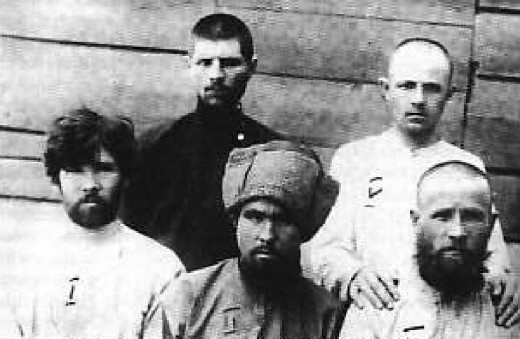
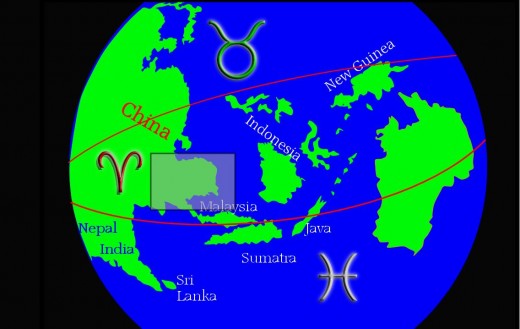
Moving swiftly on then - as you can see from my diagrams above and below, the Aries influence includes most of the Dutch East Indies as it used to be called, Indonesia as we call it now. As I mentioned above, it's kind-of interesting that the Dutch who're also within the Aries zone used-to possess Indonesia as a major-part of their empire.... well, I think it's interesting.
But before looking at that there's a few other places to consider, the Indochina Peninsula - Burma, Thailand, Laos, Cambodia and Vietnam. It's a bit hard to know what to say - we're in the sign ruled by Mars the warrior - need I say more? Say the name Vietnam - even today - and war springs to mind. Say Cambodia and the Killing Fields spring to mind.... but I'm going to start with Burma.
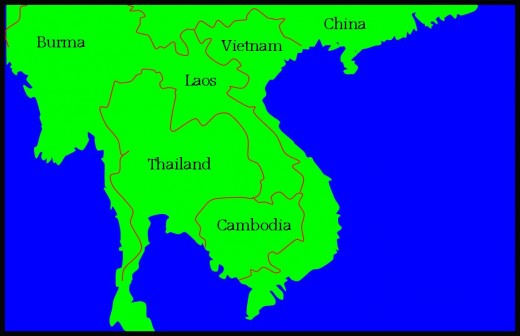
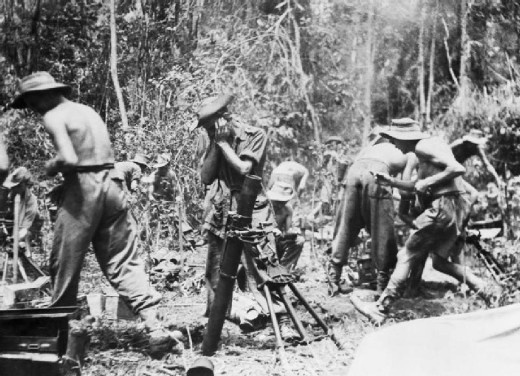
OK - Aries is the sign of empires and emperors.... and Burma was once a part of the British Empire - following three Anglo-Burmese wars during 1824 - 1885. They regained their independence when the old empire fell apart at the seams, in 1948.
To be frank - we (the brit's) left 'em in a right old mess. Since then, the country has been in one of the longest-running Civil Wars in the world, among the country's many ethnicities, and since 1962 they've been under the rule of a military junta. Not good.
Pagodas and Temples, Burma
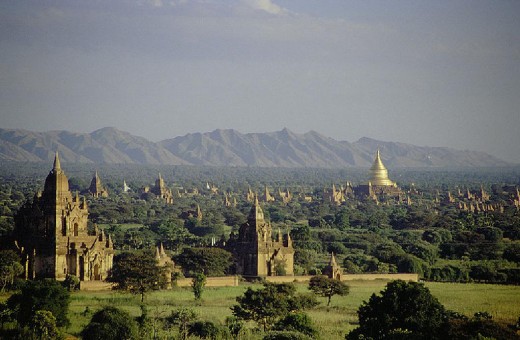
The military junta has long ruled by decree and controlled all executive, legislative, and judicial powers; suppressed nearly all basic rights; and committed human rights abuses with impunity. The junta carefully rigged the electoral framework surrounding the 2010 national elections, which were neither free nor fair. The country’s more than 2,100 political prisoners included about 429 members of the NLD, the victors in the 1990 elections.
Excerpt from the Freedom In The World 2011 report.
Thailand's emblem Garuda
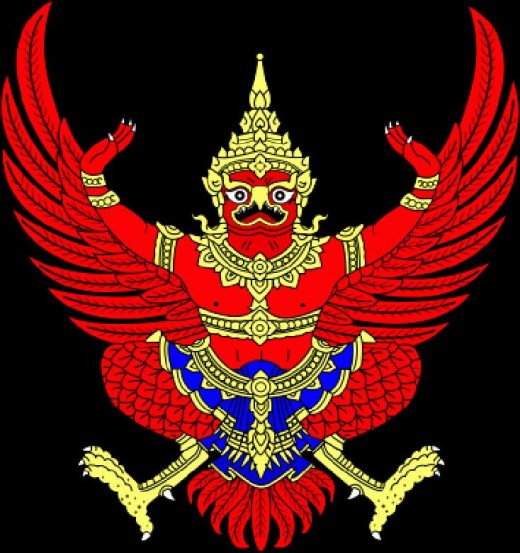
Next door to Burma lies Siam, now known as Thailand (since 1939) - the only nation on the peninsula never colonised by the Europeans - unlike their neighbours on every side. This excerpt from the US Department Of State:
Southeast Asia has been inhabited for more than half a million years. Recent archaeological studies suggest that by 4000 B.C., communities in what is now Thailand had emerged as centers of early bronze metallurgy. This development, along with the cultivation of wet rice, provided the impetus for social and political organization. Research suggests that these innovations may actually have been transmitted from there to the rest of Asia, including to China. Thai's date the founding of their nation to the 13th century. According to tradition, in 1238, Thai chieftains overthrew their Khmer overlords at Sukhothai and established a Thai kingdom. After its decline, a new Thai kingdom emerged in 1350 on the Chao Praya River.
Missing a few thousand years of no-doubt interesting history - they were a Constitutional Monarchy with a parliament and all-that, until September 2006 when there was a military coup and martial-law (Mars = martial) declared. Opponents were thrown into jail, as is usual when juntas take overrule. Bit-by-bit the Thai's won their freedoms back, military law was relaxed in stages and in December 2007 Democracy and general elections returned.
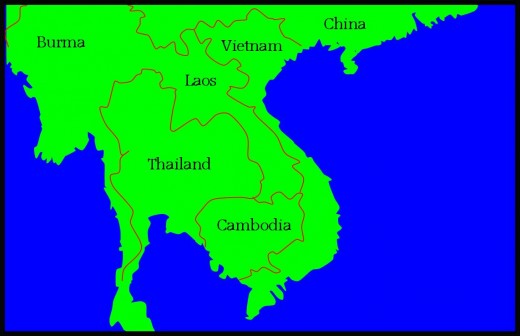
Laos
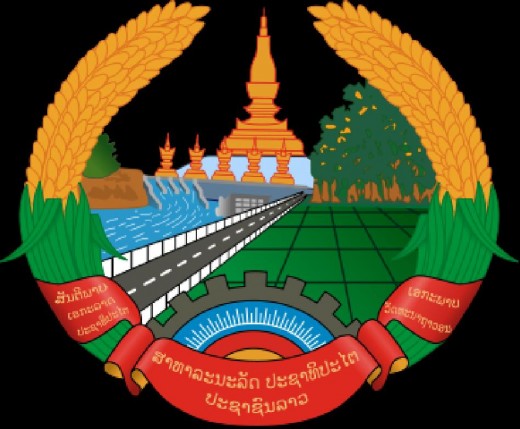
Next-door is Laos which traces its history to a Kingdom founded in the 14th century - burial urns and other kinds of sepulchres, plus bronze objects all show-up some-time around 1500 BC, and iron tools from 700 BC. The high quality of such ancient objects and metals point to a highly complex, sophisticated society. Everything was just fine thank-you until 1893 when it became a protectorate of the French. They've had a fair portion of strife since then. Laos briefly gained independence in 1945 after the Japanese occupation, but returned to French rule until they regained their autonomy in 1949, and full independence in 1953. Shortly after that, a protracted civil war finished-off the monarchy, and the Communists came to power in 1975. This from Wikipedia:
Laos was dragged into the Vietnam war. The eastern parts of the country followed North Vietnam and adopted North Vietnam as a fraternal country. Laos allowed North Vietnam to use its land as a supply route for its war against the South. In response, the United States initiated a bombing campaign against the North Vietnamese, supported regular and irregular anticommunist forces in Laos and supported a South Vietnam invasion of Laos.
Massive aerial bombardment was carried out by the United States. The Guardian reported that Laos was hit by an average of one B-52 bomb-load every eight minutes, 24 hours a day, between 1964 and 1973. US bombers dropped more ordnance on Laos in this period than was dropped during the whole of the Second World War. Of the 260 million bombs that rained down, particularly on Xianghouang Province on the Plain of Jars, some 80 million failed to explode, leaving a deadly legacy. Laos is the most heavily-bombed country, per capita, in the world.
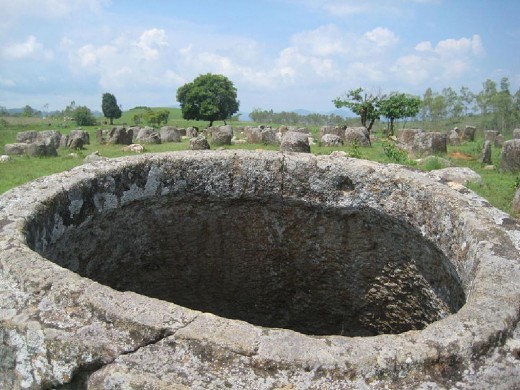
One of those sites that was so heavily bombed by the yanks was the mind-boggling Plain of Jars, large areas of which are still so dangerous they're strictly off-limits to tourists and locals alike. The jars in question are huge, some nine feet tall, weighing around 14 tons. Mostly carved of sandstone, many in granite or calcified coral, some round, some angular. Tools and human remains found inside and around a few of the weird jars suggest their use and manufacture spanned centuries. They are carbon-dated as being manufactured from 500 BC through to 800 AD, and no-one has any serious ideas about who, what or why anything at-all about these anomolies - these jars.
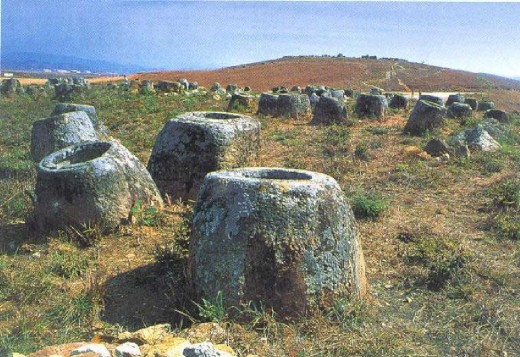
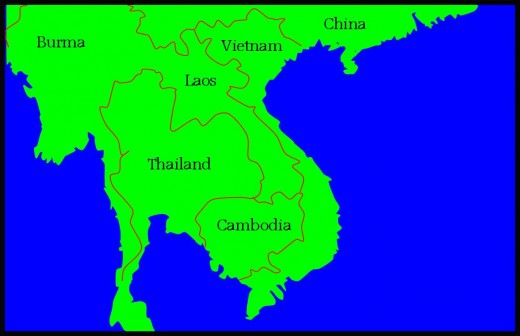
More Emperors....
Neighbouring Cambodia (from Wikipedia):
In 802 AD Jayavarman II declared himself king which marked the beginning of the Khmer Empire. Successive kings flourished which marked the Khmer empire's immense power and wealth who dominate much of Southeast Asia for over 600 years. Cambodia was ruled as a vassal between its neighbors, until it was colonized by the French in mid-19th century. Cambodia gained independence in 1953. The Vietnam war extended into Cambodia, giving rise to the Khmer Rouge, which took Phnom Penh in 1975.
Khmer Rouge

The regime, led by Pol Pot, changed the official name of the country to Democratic Kampuchea. The regime modelled itself on Maoist China during the Great Leap Forward. The regime immediately evacuated the cities and sent the entire population on forced marches to rural work projects. They attempted to rebuild the country's agriculture on the model of the 11th century, discarded Western medicine, and destroyed temples, libraries, and anything considered Western. At least a million Cambodians, out of a total population of 8 million, died from executions, overwork, starvation and disease (estimates as to how many people were killed by the Khmer Rouge range from approximately one to three million; the most commonly cited figure is two million). Simply being of Chinese, Vietnamese, Thai, or Lao ancestry meant death. Hundreds of thousands fled across the border into neighbouring Thailand.
Angkor Wat
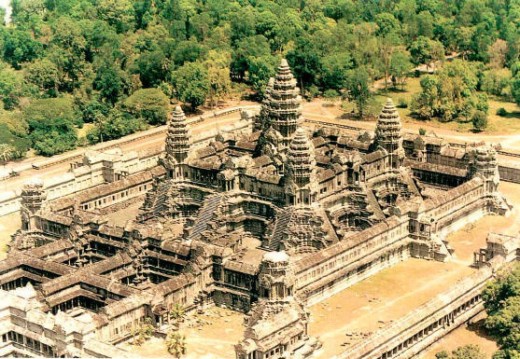
The Khmer Rouge destroyed 95 percent of the Buddhist temples that populated the landscape, and turned the few remaining into warehouses or some other mundane use. Angkor Wat somehow survived.
After years of isolation, the war-ravaged nation was reunited under the monarchy in 1993.
Next door is Vietnam.
Following the Battle of Bach Dang River in 938 AD, the Vietnamese became independent from Imperial China. The nation flourished as a royal dynasty until the Indochina Peninsula was colonised by the French in the 19th century. The Vietnamese had been under French rule for close-to six decades when Japan invaded parts of the country during WW2, in 1940. So now the Vietnamese had two foreign powers occupying their land. About now (1941) the revolutionary Ho Chi Minh came back from his 30 year tour of the world, and established his headquarters in a cave in North Vietnam. He wanted both the French and the Jap's out of his homeland and put together a group of like-minded revolutionary's and called them the Viet Minh.
Having gained support for their cause in the north and with the Jap's now being defeated, in September 1945 the Viet Minh proclaimed the beginning of an independent Vietnam called the Democratic Republic of Vietnam. The French, however, were not willing to give up their colony so easily, and the trouble began.
Ho Chi Minh asked the US to help the Vietnamese to regain their independence - after-all he HAD supplied vital intelligence to them about the Jap's during the war. But Uncle Sam was worried about the spread of Communism and decided to help the French instead, supplying them military aid. But it didn't do them much good and in 1954 the French decided to get the hell outa there - the Viet Minh were kicking their ass in battle after battle.
The French went to the UN to help them withdraw from the land, and the UN decided to draw a line in the sand, dividing the country (temporarily they said) into north and south at the 17th parallel. A ceasefire was declared by the UN and the French withdrew. The UN also arranged a general election to be held in 1956 that would erase that line at the 17th parallel, and reunite the country under one government. The US had a case of willies about that idea and refused to agree to the election, fearing the commies might win.
Gulf of Tonkin incident declassified

So they applied pressure and ensured that elections only take place to the south of the parallel. The US also had a 'preferred' candidate, and after 'eliminating' his rivals Ngo Dinh Diem was elected. He was a brutal-tyrant - communist sympathizers established the National Liberation Front - the Viet Cong - in 1960 to use guerrilla warfare against the South Vietnamese. Eventually the US backed a coup against his regime and he got a bullet in the back of his head. But this didn't stop the guerrilla attacks against the regime in the south. As this went on, the US supplied the south with increasing amounts of military aid - and then in 1964 they manufactured the Gulf of Tonkin incident, and that brought Uncle Sam into full-scale war against the Reds. Here's how the Wikipedia puts it:
The Vietnam War was a Cold-War-era military conflict that occurred in Vietnam, Laos and Cambodia from 1 November 1955 to the fall of Saigon on 30 April 1975. This war followed the First Indochina war and was fought between North Vietnam, supported by its communist allies, and the government of South Vietnam, supported by the United States and other anti-communist countries.
The last U.S. troops left Vietnam on March 29, 1973. In 1995 the Vietnamese government estimated that 4,000,000 civilians on both sides died in the war. There were 1,100,000 North Vietnamese and Viet Cong deaths. The South Vietnamese Army (ARVN) lost 266,000 soldiers, from 1959 through 1975.
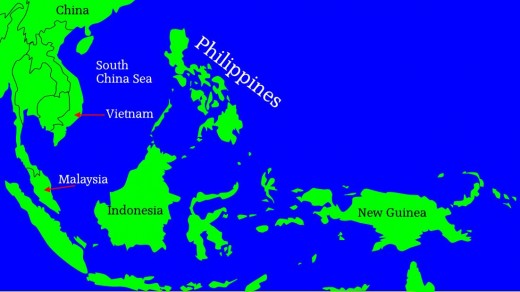
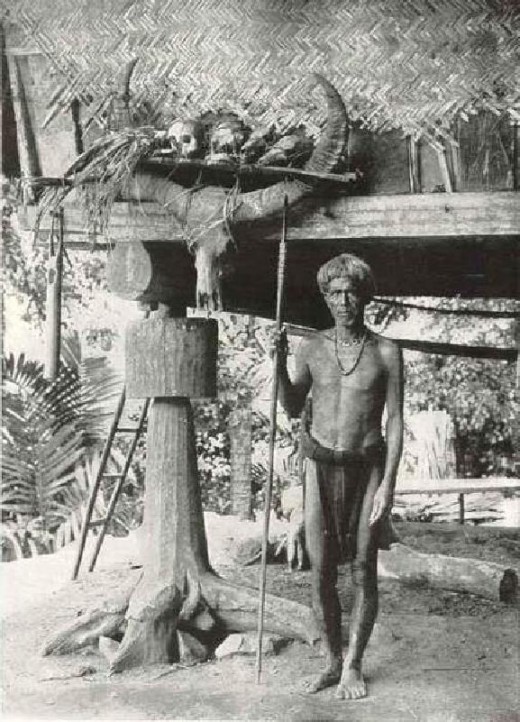
Glancing out roughly 600 miles south-west across the South China Sea - lies Indonesia, an archipelago consisting of 17000 islands. And 500 miles to the west are the Philippines - an archipelago of over 7,000 islands. Going still farther, some 18000 miles west is New Guinea.
I think it worth a mention about now that Head-Hunting has been practised by the native inhabitants on many of these islands that lie-between Indochina and Australia - worth mentioning because of course heads are specifically related to the zodiac sign at which we have been looking - Aries = heads.
Just to the south of New Guinea is Australia, the northern half of which lies squarely in this Aries sector.

Before we go looking into Australia I have to recall that way-back there in England this self-same Aries alignment was centred or focussed-on the former island of Thanet. It has to be said that though this Aries cone includes vast tracts of landscape (such as Northern Europe/Russia), as we have seen it also has a propensity for islands, Indonesia and the Philippines with 23000 islands between them, for example. I guess then that as the zodiac-sign Aries governs or represents conscious-will then islands are the landscape version or embodiment of that - conscious-will? Heads? It's just a thought......
So, in a certain sense then the continent of Australia is an island in the southern seas - a very big island, but an island nevertheless... you'll recall, I think, that astronomically speaking the constellation Aries is said to be an island in the sea of Pisces. And as I said of Thanet and now say of Australia, that manifests geophysically as actual islands that are actually in the seas actually governed (according to me) by the sign Pisces. I have to admit, I find that quite remarkable (must get out more often).
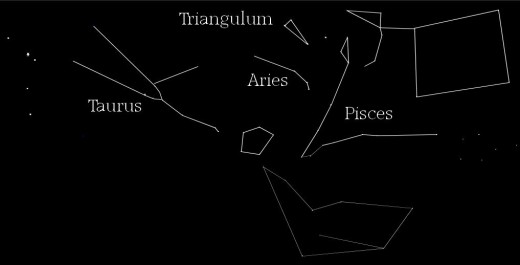
I want to jump straight to another island - only this is an island with a bit of an Aries twist. It's the colour of Mars for one thing - red - and its european name is almost Aries Rock - I'm talking about Ayres Rock ain't I? Otherwise known as Uluru - the star on the map below shows where it's located.
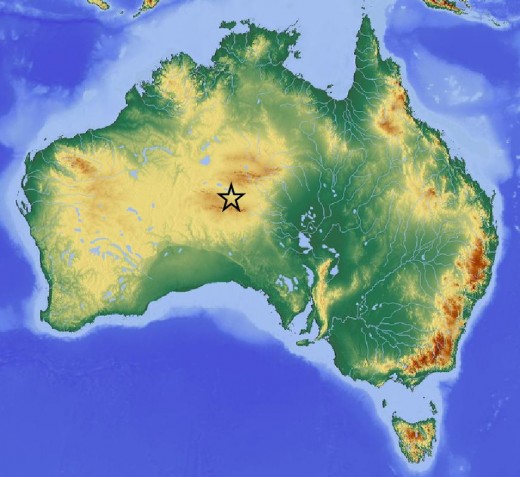
Uluru

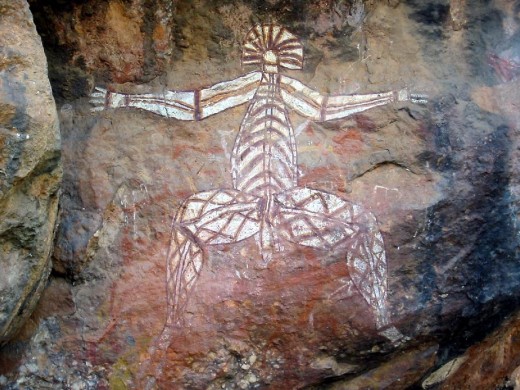
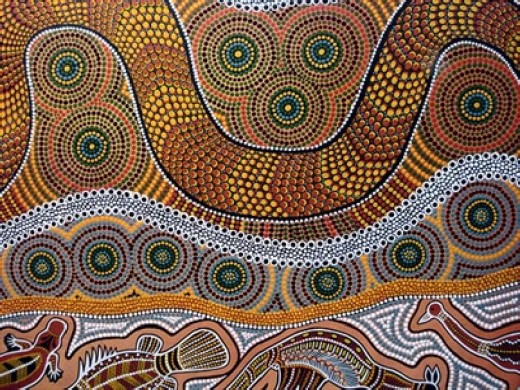
crow-man
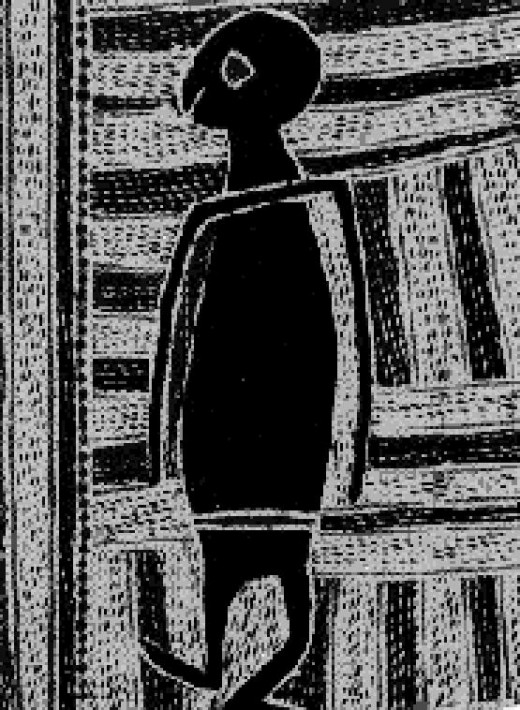
Uluru is an 'inselberg', a geological term literally meaning island mountain. An island mountain in a sea of sand.
Ernest Giles and William Gosse were the first european explorers to visit this area. While exploring in 1872, Giles sighted Kata Tjuta from a location near Kings Canyon and called it Mount Olga, while the following year Gosse observed Uluru and named it Ayers Rock.
Ayers Rock was named after Sir Henry Ayers - Australian Prime Minister. It extends down over 3 and a half miles beneath the surface. The boffins reckon that some 500 million years ago it was part of the ocean floor. Sure-enough that's probably correct but I'd like someone to tell me about the lights... there have been many reports that a light emanates from Uluru at various times of the year.
The Aborigines believe that Uluru is hollow below ground-level, and that there is an energy emanating from the rock that they call Tjukurpa. They also say the area around Uluru is inhabited by dozens of ancestral beings whose activities are recorded here and at many other sites, in petroglyphs.
Kata Tjuta - otherwise known as Mount Olga, is some 25 miles away and has as much spiritual significance to the natives as Uluru. Kata Tjuta means many heads, undoubtedly a reference to the 36 domes that make-up the range - but as mentioned elsewhere with regard to head-hunting, heads are in the domain of Aries - the sign we're investigating.
Kata Tjuta

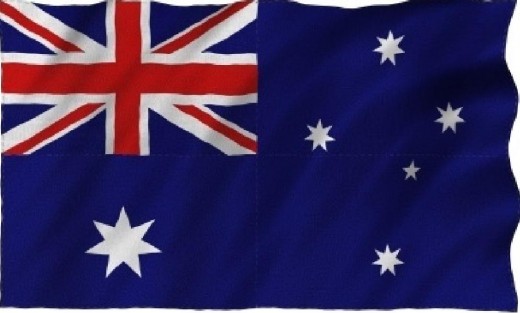
The Kremlin Star
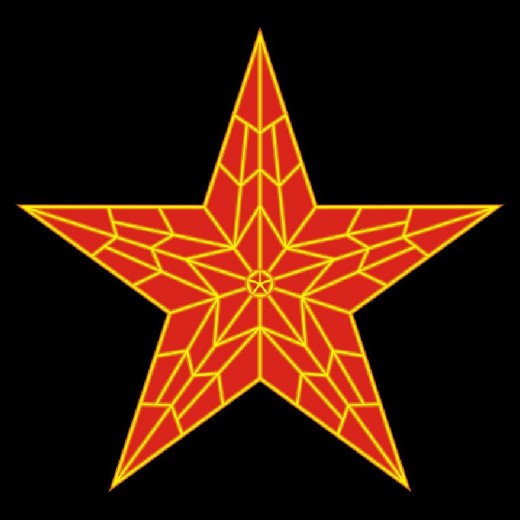
The Australian flag iterates the astrological theme we first saw at Thanet loud-and-clear too: back there on the former island between the gates of the ram and mars (Ramsgate and Margate) was the town of Broadstairs also known as Stella Maris, Star Of The Sea - and here the Australian flag is all covered in stars.
The Flag denotes Australia's global position beneath the Southern Cross - the brightest star in the Southern Hemisphere. The Star directly under the Union Jack has seven points as do the other stars - except for the small star which has five.
The 7 pointed star or septagram is a gateway symbol - a gate or entrance between this world and one of the otherworlds. The septagram is also associated with astrology probably because the ancient view of the sky had only seven planets.
The five-pointed star has strong associations with military power and war - It is used to symbolize socialism and in particular communism - and as we've seen, all through this Aries sector of the globe communism has played the starring role.

